Week 1: August 1-7, 2011
|
|
| THIS WEEK | THIS FALL | 2011 TOTAL | SITE TOTAL | |
|---|---|---|---|---|
| # birds (and species) banded | 257 (36) | 257 (36) | 1345 (69) | 32914 (107) |
| # birds (and species) repeat | 50 (17) | 50 (17) | 205 (33) | 5712 (68) |
| # birds (and species) return | 5 (2) | 5 (2) | 100 (19) | 907 (37) |
| # species observed | 68 | 68 | 140 | 202 |
| # net hours | 557.5 | 557.5 | 3394.5 | 53011.6 |
| # birds banded / 100 net hours | 46.1 | 46.1 | 39.6 | 62.1 |
Note: table does not include nocturnal banding (owls)
Bander-in-charge: Simon Duval, Gay Gruner
Assistants: Christine Barrie, Nicolas Bernier, David Davey, Jean Demers, Leah den Besten, Lima Kayello, Lisa Keelty, Barbara MacDuff, Clémence Soulard, Patricia Stotland, Matthew von Bornhoft
Notes: Last year we had our busiest ever first week of fall with 250 birds banded – and this year we’ve advanced that record slightly further with 257 over our first seven days of the season, thanks in part to great weather that allowed us to operate our full set of nets every morning. As has become tradition, one of our first two days was particularly productive, in this case 51 birds of 12 species banded on the first morning. Although some of these no doubt are local breeders or their offspring, there are always plenty of migrants this early in the season to warrant beginning our program at the start of August. Certainly the 68 species observed this week (actually below our six-year average of 71) is a far greater variety than the estimated 30-40 that breed at MBO in a typical summer, and an increase over the cumulative total of 60 species documented over the course of this summer’s MAPS season (June 6 – July 31).
Of course all 36 species we banded this week were new for the fall, but Veery, Swainson’s Thrush, and Chipping Sparrow were our first for 2011, and we also had our first Indigo Bunting return of the year. The Swainson’s Thrush continues the trend in recent years of small numbers of this species showing up at MBO long before their typical late September peak of migration, with most of these early arrivals being adults stopping over at MBO while completing their moult. Also of note, the 36 species banded this week is close to the 39 for week 1 last year, and 37 in 2009, but well above the range of 29 to 32 from 2006 to 2008 (in 2005 we had more limited banding in week 1 and only got 22 species). Although we generally don’t tally our mammal sightings, the four different skunks seen on the opening round on August 4 was noteworthy – and good reason for everyone to be wide awake first thing in the morning! We also had a large wasp nest in the shed threaten to scare off some volunteers, but Matt came to the rescue to get them out.
| # individuals banded | mean # individuals observed daily |
|---|---|
| Yellow Warbler (52) [2] | 1. Red-winged Blackbird (27) [8] |
| 2. Song Sparrow (33) [1] | 2. Cedar Waxwing (24) [1] |
| 3.American Redstart (20) [3] | 3. Yellow Warbler (18) [10] |
| 4. Cedar Waxwing (14) [5] | 4. Black-capped Chickadee (18) [3] |
| 5. Nashville Warbler (12) [-] | 5. American Robin (17) [2] |
| 6. Black-capped Chickadee (10) [6] | 6. Common Grackle (14)[5] |
| 7. American Robin (9) [4] | 7. American Goldfinch (13) [7] |
| 8.Tennessee Warbler (8) [10] | 8. American Crow (12) [6] |
| 8. Common Yellowthroat (8)[9] | 9. Song Sparrow (11) [4] |
| 8. Black-throated Blue Warbler (8) [-] 8. Baltimore Oriole (8) [-] |
10. Red-eyed Vireo (6) [-] |
For the sixth straight year, Yellow Warbler and Song Sparrow were the two most frequently banded species in the first week of fall. Coming out on top this year, Yellow Warbler evens the score, having also been the most abundant in 2008 and 2009, while Song Sparrow took top spot in 2006, 2007, and 2010. The count of Yellow Warblers this week was remarkable, given that the fall season total for the species has been so consistent to date, ranging between 39 and 50 annually since 2005 – so to have a new season record after just one week was quite a surprise! The previous Yellow Warbler totals for week 1 have ranged from 22 to 29, in other words around half of the season total, so if the pattern continues, we might have a chance of reaching 100 this fall. Fall numbers of American Redstart have steadily increased each year, and with 20 banded this week, the season appears off to a good start for them again. Other early warbler migrants among the top ten this week included Nashville, Tennessee, Black-throated Blue, and Common Yellowthroat. Nashville Warbler in fifth place was the biggest surprise, having only once before (2007) made the top ten this early in the season, and with fewer individuals (7) in that case. Like the Swainson’s Thrushes, the Nashville and Tennessee Warblers arriving in early August are generally molt migrants showing up around 6 weeks earlier than the peak of migration for their species. After two meager years of Baltimore Oriole numbers, the 8 banded this week give us some hope that this fall might be better.
Nine of the ten most abundant species in week 1 last year also made the list this year, the only difference being Red-eyed Vireo sneaking in at tenth place, replacing Indigo Bunting. However, the order of the species has shuffled a fair bit from one year to the next. Red-winged Blackbird topped this week’s list, the first time since 2007 that it has dominated the first week of fall. Cedar Waxwing dropped down to second place this year, but still with numbers well above the six-year average for this time of year. Reflecting the high capture rate, Yellow Warbler vaulted up to third place among species observed this week, by far its highest rank ever for any week in fall. Song Sparrow down in ninth place is of note, since it has been in the top five for week 1 in every previous year. Although there weren’t enough Tree Swallows over the course of the week to crack the top ten, the 22 individuals observed in two flocks on August 3 was a high single day count for fall.
Once again fall migration is off to a great start at MBO, and we look forward to welcoming not only thousands more birds by the end of our season, but also dozens of returning and new volunteers. Please check out our volunteer section if you would like to help out, and follow our weekly reports from now through to the end of October.
|
|
Week 2: August 8-14, 2011
|
|
| THIS WEEK | THIS FALL | 2011 TOTAL | SITE TOTAL | |
|---|---|---|---|---|
| # birds (and species) banded | 139 (34) | 396 (42) | 1484 (69) | 33053 (108) |
| # birds (and species) repeat | 44 (17) | 94 (23) | 249 (34) | 5756 (68) |
| # birds (and species) return | 1 (1) | 6 (2) | 101 (19) | 908 (37) |
| # species observed | 75 | 82 | 140 | 202 |
| # net hours | 560.0 | 1117.5 | 3954.5 | 53571.6 |
| # birds banded / 100 net hours | 24.8 | 35.4 | 37.5 | 61.7 |
Note: table does not include nocturnal banding (owls)
Bander-in-charge: Simon Duval, Gay Gruner
Assistants: Christine Barrie, Nicolas Bernier, David Davey, Rui de Jesus, Jean Demers, Nicki Fleming, Barbara Frei, Lima Kayello, Lisa Keelty, Chris Murphy, Clémence Soulard, Rodger Titman, Matthew von Bornhoft
Notes: Except in 2006, the number of birds banded in week 2 has always tended to drop off from week 1, and that pattern is especially stark this year, with this week’s total of 139 banded representing only 54% of our count from last week. To some extent this probably reflects a fairly good count of locally-produced young that we band in the first week as a supplement to the migrants, but it also seems like there tends to be a slight lull between the first wave of really early migrants that push through in early August (or even late July) and the next group that begins to arrive later in August. The lower numbers this week certainly didn’t reflect lack of effort, as we were able to get in our maximum of 560 net hours this week (16 nets open for 5 hours daily), but might have been influenced by the persistenly warm weather, with highs between 25 and 28 on six out of seven days, and nightly lows in the mid to high teens.
|
|
While the number of birds banded this week was the lowest ever for week 2, the 75 species observed over the course of the week was slightly above the six-year average of 7 Among them were 14 new species for this fall: Canada Goose, Green Heron, Spotted Sandpiper, American Woodcock, Great Horned Owl, Least Flycatcher, Yellow-bellied Flycatcher, Purple Martin, Northern Rough-winged Swallow, Brown Creeper, Red-breasted Nuthatch, Black-throated Green Warbler, Canada Warbler, and Slate-colored Junco. Most of these species are right on schedule, although in many years Black-throated Green Warblers don’t show up until the last week of August, and Brown Creepers are rare before mid-September. The biggest surprise though was the Slate-colored Junco, our first ever record for August; it’s possible they nested this year in the adjacent Morgan Arboretum. Species banded for the first time this fall were Yellow-shafted Flicker, Least Flycatcher, Yellow-bellied Flycatcher, Brown Creeper, Canada Warbler, and Red-winged Blackbird. Also, as noted in the caption for the photo of the week, we banded Wood Ducks for the first time in MBO’s history, taking advantage of the fact that a group of four had been hanging around for several days and were easily approachable. We have Wood Ducks breeding at MBO each year but have never had an opportunity to band them until now, so this will be an opportunity to see whether any of these individuals return next spring.
| # individuals banded | mean # individuals observed daily |
|---|---|
| 1. American Redstart (22) [3] | 1. Red-winged Blackbird (31) [1] |
| 2. Song Sparrow (16) [2] | 2. Cedar Waxwing (24) [2] |
| 3.Yellow Warbler (15) [1] | 3. Black-capped Chickadee (18) [4] |
| Common Yellowthroat (10) [8] | American Crow (17) [8] |
| 5. Cedar Waxwing (7) [4] | 5. American Robin (16) [5] |
| 6. Ovenbird (6) [-] | 6. Song Sparrow (13)[9] |
| 6. Tennessee Warbler (6) [8] | 7. American Goldfinch (12) [7] |
| 8.Traill’s Flycatcher (5) [-] | 8. Yellow Warbler (10) [3] |
| 8. Baltimore Oriole (5)[8] | 9. Common Grackle (9) [6] |
| 10. Red-eyed Vireo (4) [-] 10. Black-capped Chickadee (4) [6] 10. Rose-breasted Grosbeak (4) [-] |
10. Common Yellowthroat (7) [-] |
The top three species banded remained the same as last week, except for Yellow Warbler and American Redstart swapping places. This is only the second time that American Redstart has taken top spot this early in fall (the other occasion being in 2008), and the 22 individuals banded is a record for week 2. With another 15 Yellow Warblers banded this week, the new season record is extended to 67 individuals, with the total surely to climb further before their migration tapers off near the end of August. The rest of the top ten shows less similarity to last week’s results, with four new species added, and little carry-over from the strong first week showing of Nashville Warbler (only two were banded this week, compared to last week’s 12). With five more Baltimore Orioles banded this week, the season total of 13 is already better than 2009 (12) and approaching last year’s 15, but still far short of the record of 62 set in 2006.
Among species observed, the top nine species are the same as last week, with four of them (Red-winged Blackbird, Cedar Waxwing, American Robin, and American Goldfinch) even maintaining exactly the same rank this week. This marks the first time that Red-winged Blackbird has taken the top spot in week 2 of fall, and is actually the first time it has even been in the top ten for this week since 2007! Usually the local breeders disperse by late July, occasionally lingering into the first week of August, and then we see large flocks returning in the second half of fall, typically peaking in late October. For whatever reason (perhaps somewhat delayed nesting due to heavy rain early in summer?), the blackbirds have been hanging around longer this year; it will be interesting to see when they finally depart. Cedar Waxwings have also never before been so common at this time of year. On the other hand, Black-capped Chickadees were reliably consistent (over the past six years, the mean daily count for week 2 has ranged only from 15 to 18, resulting in a rank of third to eighth depending on the abundance of other species). American Crow and Song Sparrow both moved up in rank compared to week 1, while Yellow Warbler dropped off substantially, as also reflected in the far lower number banded. The only new addition to the list this week was Common Yellowthroat, replacing Red-eyed Vireo. Again we had some good swallow migration this week with 27 individuals of four species on August 11, and our only Purple Martin of the season to date among 30 swallows on August 12.
So far this fall we’ve had one week with a record high number of birds banded, and another with a record low … what will week 3 bring us?
|
|
Week 3: August 15-21, 2011
|
|
| THIS WEEK | THIS FALL | 2011 TOTAL | SITE TOTAL | |
|---|---|---|---|---|
| # birds (and species) banded | 136 (33) | 532 (45) | 1620 (71) | 33189 (108) |
| # birds (and species) repeat | 35 (16) | 129 (26) | 284 (36) | 5791 (68) |
| # birds (and species) return | 3 (3) | 9 (5) | 104 (20) | 911 (37) |
| # species observed | 78 | 88 | 141 | 202 |
| # net hours | 480.0 | 1597.5 | 4434.5 | 54051.6 |
| # birds banded / 100 net hours | 28.3 | 33.3 | 36.5 | 61.4 |
Note: table does not include nocturnal banding (owls)
Bander-in-charge: Simon Duval, Gay Gruner
Assistants: Christine Barrie, Sue Bishop, Rui de Jesus, Jean Demers, Andrée-Anne Deschamps, Liette Fortier, Barbara Frei, Alison Hackney, Lima Kayello, Lisa Keelty, Tony James Kouach, Le Duing Lang, Francine Marcoux, Mevin Mongey, Chris Murphy, Cat Spina, Benoit Piquette, Ahmad Shah, Clémence Soulard, Bonnie Soutar, Rodger Titman, Monique Venne, Matthew von Bornhoft
Notes: Last week’s report ended with us wondering whether week 3 would be more like the record high numbers of week 1 or the record low of week 2. Unfortunately, the lull in migration continued, with the 136 birds banded this week the second lowest for this period (only in 2007 did we band fewer birds in week 3). We also finally ran out of luck with weather at the end of this week, with Sunday rained out.
|
|
Although the 78 species observed this week is well within the range of 72 to 84 observed during week 3 over the past five years, the cumulative total of 88 species is the lowest ever at this point in the season, with the count ranging from 92 to 99 in previous years. Hopefully many of the species missed to date will show up at MBO soon. The six new species observed this week were American Bittern, Belted Kingfisher, Yellow-bellied Sapsucker, Olive-sided Flycatcher, Yellow-rumped Warbler, and Scarlet Tanager; the bittern was actually our first for all of 2011. With the arrival of the first Yellow-rumped Warbler, we can’t help but wonder whether this fall will bring a repeat performance of the spectacular numbers we observed from late September to mid-October last year, or instead a more traditional “odd year” drop in numbers (since 2005 we have documented a dramatic two-year pattern to Yellow-rumped Warbler numbers, with an average of 110 banded over three “odd” years, and an average of 1538 banded over three “even” years). As for birds banded this week, Scarlet Tanager was new for the year, while Great Crested Flycatcher and American Goldfinch were our first for fall. Also of note, a young coyote was seen along the census trail on Saturday; although we hear them most years (especially during our owling later in fall), we have only rarely seen them on site.
| # individuals banded | mean # individuals observed daily |
|---|---|
| 1. American Redstart (25) [1] | 1. Cedar Waxwing (29) [2] |
| 2. Song Sparrow (22) [2] | 2. Black-capped Chickadee (28) [3] |
| 3.Common Yellowthroat (10) [4] | 3. Song Sparrow (17) [6] |
| 4. Traill’s Flycatcher (7) [8] | 4. American Crow (17) [4] |
| 5. Cedar Waxwing (6) [5] | 5. American Robin (13) [5] |
| 5. Ovenbird (6) [6] | 6. American Goldfinch (12)[7] |
| 7. Yellow-bellied Flycatcher (5) [-] | 7. American Redstart (11) [-] |
| 7. Tennessee Warbler (5) [6] | 8. Common Yellowthroat (10) [10] |
| 7. Yellow Warbler (5)[3] | 9. Red-eyed Vireo (6) [-] |
| 10. Black-capped Chickadee (4) [10] 10. Nashville Warbler (4) [-] 10. Black-and-white Warbler (4) [-] 10. Magnolia Warbler (4) [6] |
10. Ruby-throated Hummingbird (6) [-] |
American Redstart took top spot among birds banded for a second straight week, and that came as no surprise as it has also been number one in week 3 every year since 2007, except when pushed into second place by an unusually high number of Song Sparrows in 2009. Meanwhile Song Sparrow was the runner-up for a second week in a row, also as expected for this time of year. Common Yellowthroat moved up one position from last week, while Yellow Warbler tumbled to seventh place, showing that the big push observed during week 1 doesn’t seem to be carrying on to the extent that we expected it might. Traill’s Flycatcher had an unusually strong showing for week 3, by which time it is usually already tapering off in numbers, and similarly this was one of our best weekly totals ever for Yellow-bellied Flycatcher. Although Cedar Waxwing is a common species at MBO, it has traditionally been relatively scarce in the second half of August, and this is actually the first time it has ever made the top ten for week 3 – and topping the list of species observed is all the more surprising. Small numbers of Black-capped Chickadees, presumably local offspring, continue to be banded each week; otherwise the remaining species in the bottom half of the top ten comprised several more warblers, most of which we expect will soon increase in numbers.
As already noted, we were surprised to see the mean daily count of Cedar Waxwings top all other species this week. They only barely edged out Black-capped Chickadee, which is traditionally a dominant species at this time of year, in the top three every year except 2006. Song Sparrow moved up to third place this week, followed by a solid block of “Americans” – American Crow and American Robin maintained their rank from last week, while American Goldfinch edged up by one spot, and American Redstart jumped in at seventh place. Common Yellowthroat also increased a bit compared to last week, while Red-eyed Vireo and Ruby-throated Hummingbird numbers grew enough to make rare appearances in the top ten. Last week’s top species, Red-winged Blackbird, dropped off the list entirely this week, going from a daily mean count of 31 to a total count this week of just 15 individuals. Although a drastic change, this is what we usually observe in week 1 or 2, so it appears that they were in fact just a bit late this year. The other species dropping out of the top ten since last week were Yellow Warbler and Common Grackle.
After a record busy first week followed by two unusually slow ones, we are now wondering whether the first week was a fluke, or the big numbers will resume once a good cold front moves through. Week 4 should give us a better idea which of these scenarios is closer to the truth…
|
|
Week 4: August 22-28, 2011
|
|
| THIS WEEK | THIS FALL | 2011 TOTAL | SITE TOTAL | |
|---|---|---|---|---|
| # birds (and species) banded | 240 (37) | 772 (52) | 1860 (74) | 33429 (108) |
| # birds (and species) repeat | 42 (14) | 171 (27) | 326 (37) | 5833 (68) |
| # birds (and species) return | 2 (2) | 11 (7) | 106 (20) | 913 (37) |
| # species observed | 77 | 97 | 141 | 202 |
| # net hours | 426.0 | 2023.5 | 4860.5 | 54477.6 |
| # birds banded / 100 net hours | 56.4 | 38.2 | 38.3 | 61.3 |
Note: table does not include nocturnal banding (owls)
Bander-in-charge: Simon Duval, Gay Gruner
Assistants: Christine Barrie, Nicolas Bernier, Sue Bishop, Rui de Jesus, Jean Demers, Nicki Fleming, Maryse Forest-Tremblay, Barbara Frei, Alison Hackney, Frédéric Hareau, Lima Kayello, Lisa Keelty, Barbara MacDuff, Benoit Piquette, Francine Piquette, François Rousseaux, Ahmad Shah, Clémence Soulard, Patricia Stotland, Elise Titman, Rodger Titman
Notes: After two unusually quiet weeks, we were happy to see a substantial increase in bird migration this week. The 240 birds banded this week is actually a record high count for week 4, despite (or perhaps because of?) some unsettled weather that limited us to minimal banding effort on Monday and Thursday, and also reduced our hours a bit on Sunday. Taken together, that resulted in our birds banded per 100 net hours being almost exactly double what it was last week. Much of this was thanks to a spectacular Friday morning, when we banded 112 birds of 28 species, both record highs for August by a wide margin. This included a particularly impressive 90 individuals of 17 warbler species. Surprisingly this wasn’t linked to a major cold front; temperatures on Friday were only a few degrees cooler than the day before.
|
|
While numbers banded this week were great, observations remained a bit below average, with 77 species reported this week, bringing the cumulative total for the season up to 97, whereas from 2005 through 2009 we had reached triple digits by this time of year. The nine species added to the fall 2011 list this week were Common Loon, Sharp-shinned Hawk, Herring Gull, Common Nighthawk, Philadelphia Vireo, Brown Thrasher, and a trio of “B” warblers (Blackpoll, Bay-breasted, and Blackburnian). The nighthawk was our first of the year, and only the fourth ever observed at MBO; all sightings have occurred in the second half of August. Among the influx of migrants to our nets this week were three species banded for the first time this year (Philadelphia Vireo, Blue Jay, and Blackburnian Warbler), and four others for the first time this fall (Sharp-shinned Hawk, Blackpoll Warbler, Bay-breasted Warbler, and Black-throated Green Warbler). All three of the species banded for the first time in 2011 came during our big Friday.
| # individuals banded | mean # individuals observed daily |
|---|---|
| 1. Magnolia Warbler (43) [10] | 1. Cedar Waxwing (25) [1] |
| 2. American Redstart (31) [1] | 2. Red-winged Blackbird (19) [-] |
| 3.Tennessee Warbler (23) [7] | 3. Black-capped Chickadee (17) [2] |
| 4. Chestnut-sided Warbler (15) [-] | 4. American Crow (17) [4] |
| 5. Ovenbird (12) [5] | 5. Common Grackle (16) [-] |
| 5. Common Yellowthroat (12) [3] | 6. American Goldfinch (14)[6] |
| 7. Nashville Warbler (9) [10] | 7. American Robin (14) [5] |
| 7. Song Sparrow (9) [2] | 8. American Redstart (10) [7] |
| 7. Indigo Bunting (9)[-] | 9. Blue Jay (8) [-] |
| 10. Black-capped Chickadee (6) [10] 10. Black-throated Blue Warbler (6) [-] |
10. Magnolia Warbler (8) [-] |
Magnolia Warblers were the most frequently banded species in week 4 in five of six previous fall seasons at MBO, and this year stayed true to the pattern, with a sharp increase in numbers from last week. American Redstart is getting to be almost as predictable, coming in as the runner-up for week 4 for the fifth consecutive year. More of a surprise was Tennessee Warbler, of which we’ve never before banded more than 10 at this time of year, so this suggests they’re either early this fall, or might be coming in larger than usual numbers. Even more surprising was the count of 15 Chestnut-sided Warblers, a single-week record for MBO (and more than we banded in the entire 2006 or 2007 fall seasons). The warbler domination continued with good numbers of Ovenbirds and Common Yellowthroats, and a slight increase from last week for Nashville Warbler, plus Black-throated Blue Warblers barely making it on the list in a tie for tenth place. The only others to crack the top ten this week were Song Sparrow and Indigo Bunting in a tie for seventh, and Black-capped Chickadee hanging on in tenth place for a third week in a row.
In terms of species observed, Cedar Waxwing maintains its atypical dominance for another week. The biggest surprise here though was the return of Red-winged Blackbirds, usually quite scarce in late August (a mean of fewer than 5 per day over the previous six years). With them were Common Grackles, also vaulting back into the top five this week, although a bit less unusual for this time of year. The grackles split apart last week’s cluster of Americans, with American Crow staying in fourth place for yet another week and American Goldfinch hanging on at number six, but American Robin and American Redstart dropping down to seventh and eighth place respectively. Blue Jay and Magnolia Warbler were new entries at the bottom of the list. This marks the first year ever that Song Sparrow has not been in the top ten at this point in fall, despite being the third most numerous last week. Others dropping off were last week’s “bottom three” (Common Yellowthroat, Red-eyed Vireo, and Ruby-throated Hummingbird).
After four weeks, our overall numbers for the season are close to average, but the excitement of the past few days has us hopeful that a further influx of warblers will soon be coming our way. Our top three species banded so far this fall are American Redstart (98), Song Sparrow (80), and Yellow Warbler (75), but with more than two-thirds of the season yet to come, we know that list will change substantially before we’re done.
|
|
Week 5: August 29 – September 4, 2011
|
|
| THIS WEEK | THIS FALL | 2011 TOTAL | SITE TOTAL | |
|---|---|---|---|---|
| # birds (and species) banded | 311 (36) | 1083 (55) | 2171 (74) | 33740 (108) |
| # birds (and species) repeat | 39 (13) | 210 (27) | 365 (37) | 5872 (68) |
| # birds (and species) return | 2 (2) | 13 (7) | 108 (20) | 915 (37) |
| # species observed | 86 | 107 | 146 | 202 |
| # net hours | 531.6 | 2555.1 | 5392.1 | 55009.2 |
| # birds banded / 100 net hours | 58.5 | 42.4 | 40.3 | 61.3 |
Note: table does not include nocturnal banding (owls)
Bander-in-charge: Simon Duval, Gay Gruner
Assistants: Mike Beaupré, Sue Bishop, Rui de Jesus, Jean Demers, Andrée-Anne Deschamps, Tammy Elliott, Lima Kayello, Lisa Keelty, Louise Lebel, Francine Marcoux, Daniel Martin, Barbara MacDuff, Chris Murphy, Catherine Russell, Ahmad Shah, Clémence Soulard, Bonnie Soutar, Elise Titman, Rodger Titman
Notes: This week started off with a very slow Monday, and we thought that the yo-yo season of busy/slow weeks was going to continue. But then on four other days during the week we banded 50 or more birds, bringing our total for the week to 311 – for the second week in a row, a record. After the strong pulse of migration over the past two weeks, our season total now stands at 1084, slightly ahead of last year’s record pace, while the 55 species banded to date is just below average for this time of fall.
|
|
So far our count of species observed this season has been lagging behind past years, but with the ten species added this week, the total of 107 nearly matches our six-year average for the end of week 5. The newcomers were Common Merganser, Double-crested Cormorant, Greater Yellowlegs, Northern Harrier, Yellow-billed Cuckoo, Winter Wren, Northern Parula, Wilson’s Warbler, Rusty Blackbird, and House Finch. The merganser, yellowlegs, and cuckoo were also new for 2011, and the cuckoo was only the fourth one in MBO’s history, following two in 2005 and one last August. We added Yellow-bellied Sapsucker, Yellow-rumped Warbler, and Wilson’s Warbler to our list of species banded this fall, but none of them were new for the year.
| # individuals banded | mean # individuals observed daily |
|---|---|
| 1. Magnolia Warbler (79) [1] | 1. Canada Goose (36) [-] |
| 2. Tennessee Warbler (52) [3] | 2. Cedar Waxwing (32) [1] |
| 3.American Redstart (26) [2] | 3. American Crow (23) [4] |
| 4. Nashville Warbler (22) [7] | 4. Black-capped Chickadee (23) [3] |
| 5. Northern Waterthrush (15) [-] | 5. Magnolia Warbler (17) [10] |
| 5. Wilson’s Warbler (15) [-] | 6. American Goldfinch (15)[6] |
| 7. Yellow-bellied Flycatcher (8) [-] | 7. Tennessee Warbler (10) [-] |
| 7. Common Yellowthroat (8) [5] | 8. American Redstart (10) [8] |
| 9. Ovenbird (7)[5] | 9. American Robin (8) [7] |
| 10. Chestnut-sided Warbler (7) [4] | 10. Nashville Warbler (6) [-] |
Warblers were again dominant in the nets this week, with the only exception in the top ten being Yellow-bellied Flycatcher in seventh place. Magnolia Warbler took top spot, as it has every year in week 5. Second place was secured by an impressive wave of Tennessee Warblers – we have never before banded more than 20 in a week in fall, and in three of our previous six years, our total for the entire season was lower than the 52 banded this week. American Redstart numbers remained strong, while Nashville Warblers are increasing as we head into September, consistent with the normal trend. There was a sudden spike in Northern Waterthrush numbers this week, similar to what we observed in week 5 last year. Wilson’s Warbler also jumped into the top ten this week with 15 birds banded, right in line with the typical peak of migration for this species. Common Yellowthroat remained in the top ten, although the total of 48 banded to date this fall is somewhat below normal for this time of year. Ovenbird and Chestnut-sided Warbler rounded out the top ten this week, with both species on pace for potentially record high totals this fall.
Canada Goose came from out of nowhere to take top spot this week on the list of species observed, similar to what happened this week in 2009. That pushed Cedar Waxwing down to second place, still the best ever showing for the species at this time of year, with the previous high daily mean being only 16, half of what we observed this week. American Crow and Black-capped Chickadee swapped third and fourth place this week, although just by a matter of a couple of individuals, as both rounded off to a daily mean of 23 individuals, similar to last year’s numbers. The four warblers that topped our banding list this week were common enough to dominate the middle/lower part of the list of species observed, joined by American Goldfinch, holding steady in sixth place, and American Robin hanging on in ninth spot. Somewhat surprisingly, this is the first time we have had more than two warbler species on the list in week 5.
|
|
Week 6: September 5 – 11, 2011
|
|
| THIS WEEK | THIS FALL | 2011 TOTAL | SITE TOTAL | |
|---|---|---|---|---|
| # birds (and species) banded | 257 (37) | 1340 (56) | 2428 (74) | 33997 (108) |
| # birds (and species) repeat | 45 (17) | 255 (30) | 410 (39) | 5917 (68) |
| # birds (and species) return | 1 (1) | 14 (8) | 109 (20) | 916 (37) |
| # species observed | 77 | 112 | 146 | 202 |
| # net hours | 480.0 | 3035.1 | 5872.1 | 55489.2 |
| # birds banded / 100 net hours | 53.5 | 44.2 | 41.3 | 61.2 |
Note: table does not include nocturnal banding (owls)
Bander-in-charge: Simon Duval, Gay Gruner
Assistants: Mike Beaupré, Nicolas Bernier, Jean Demers, Leah Den Besten, Alison Hackney, Lima Kayello, Lisa Keelty, Francine Marcoux, Barbara MacDuff, Betsy McFarlane, Chris Murphy, Armin Nazemi, Joey O’Connor, Kevin Poirier, Catherine Russell, Clémence Soulard, Bonnie Soutar, Alex Stone, Patricia Stotland, Rodger Titman, Matthew von Bornhoft
Notes: After two consecutive weeks of record numbers for late August and early September, this week’s banding total represents a more average count for this time of year. The week began with Monday being rained out, then two relatively busy days with 63 and 90 birds banded. However, afterwards migration quieted down, with between 14 and 41 birds banded daily for the rest of the week, despite operating full net hours. Our season total has now fallen behind where we were at this time last year, but is still greater than in any of our earlier years. With Eastern Phoebe as this week’s only new species banded for the fall, our total of 58 species to date is now the lowest we’ve ever had by this point in the season.
|
|
Just as the number of species banded to date this fall is lower than ever before, our count of species observed is also unusually low. The five additions this week were Osprey, Broad-winged Hawk, Northern Goshawk, Orange-crowned Warbler, and White-crowned Sparrow, bringing our total to 112. We also had our first Black-capped Chickadee return of the fall, one of our resident birds that had avoided us for a while
| # individuals banded | mean # individuals observed daily |
|---|---|
| 1. Magnolia Warbler (52) [1] | 1. Canada Goose (65) [1] |
| 2. Tennessee Warbler (37) [2] | 2. Broad-winged Hawk (44) [-] |
| 3.Nashville Warbler (21) [4] | 3. American Crow (33) [3] |
| 4. Wilson’s Warbler (18) [5] | 4. Black-capped Chickadee (26) [4] |
| 5. Red-eyed Vireo (11) [-] | 5. American Goldfinch (20) [6] |
| 6. American Redstart (10) [3] | 6. Cedar Waxwing (17)[2] |
| 7. Indigo Bunting (9) [-] | 7. Magnolia Warbler (14) [5] |
| 7. White-throated Sparrow (9) [-] | 8. Tennessee Warbler (12) [7] |
| 9. Blackpoll Warbler (8)[-] | 9. Blue Jay (9) [-] |
| 10. Cedar Waxwing (7) [-] 10. Common Yellowthroat (7) [7] |
10. Song Sparrow (8) [-] |
The most frequently banded species this week were an interesting mix, with the top four nearly matching last week’s list, but with five new entries in the remainder of the top ten. Magnolia Warbler took the top spot for week 6, for the fourth time in the past six years, and the total of 181 banded so far this season puts the species far in front of all others. In second place for a second straight week, and moving into third for the season, is Tennessee Warbler, now up to a season total of 131, which beats last year’s record of 11 American Redstart dropped from third place last week to sixth this week, but increased to a season total of 134, in striking distance of last year’s record of 149. Nashville and Wilson’s Warbler numbers were similar to week 5, and each moved up one spot in the table thanks to the drop by American Redstart. Red-eyed Vireo can be a bit erratic but is often common in week 6, with this marking the fifth year in a row that it is in the middle of the top ten list for this week. On the contrary, the 9 Indigo Buntings banded this week is a record for week 6. Rounding out the top ten were some early White-throated Sparrows, a slightly above-average count of Blackpoll Warblers, some more Common Yellowthroats, and enough Cedar Waxwings to set a new season record of 44 banded, with more likely yet to come.
Canada Goose remained the most abundant bird observed this week, mirroring the pattern from 2009, but quite different from most other years when the species was either in the mid to lower reaches of the top ten or not even on the list this early in fall. The big surprise this week was the dominant showing by Broad-winged Hawk, thanks primarily to a record-shattering estimate of 300 individuals kettling over the site on Saturday September 10. American Crow and Black-capped Chickadee remained in third and fourth place with numbers similar to last week, American Goldfinch moved up slightly to fifth place, and Cedar Waxwing dropped to sixth from second at a time of year when numbers are more typically increasing, but their abundance has been atypical throughout this fall. Magnolia and Tennessee Warblers remained unusually abundant this week, while Blue Jay and Song Sparrow squeaked in at the bottom of this week’s list.
|
|
Week 7: September 12 – 18, 2011
|
|
| THIS WEEK | THIS FALL | 2011 TOTAL | SITE TOTAL | |
|---|---|---|---|---|
| # birds (and species) banded | 217 (37) | 1557 (58) | 2645 (74) | 34214 (108) |
| # birds (and species) repeat | 52 (16) | 307 (33) | 462 (42) | 5969 (68) |
| # birds (and species) return | 1 (1) | 15 (8) | 110 (20) | 917 (37) |
| # species observed | 84 | 120 | 149 | 202 |
| # net hours | 472.0 | 3507.1 | 6344.1 | 55961.2 |
| # birds banded / 100 net hours | 46.0 | 44.4 | 41.7 | 61.1 |
Note: table does not include nocturnal banding (owls)
Bander-in-charge: Simon Duval, Gay Gruner
Assistants: Nathalie Barbeau, Christine Barrie, Nicolas Bernier, Sue Bishop, Joel Coutu, Leah Den Besten, Sarah Dixon, Tammy Elliot, Alison Hackney, Frédéric Hareau, Lima Kayello, Lisa Keelty, Marie-Pier Lussier, Charlotte Maloney, Francine Marcoux, Barbara MacDuff, Betsy McFarlane, Scott Pemberton, Catherine Russell, Ahmad Shah, Elise Titman, Rodger Titman, Matthew von Bornhoft
Notes: The slow pace of migration from the latter part of week 6 continued throughout most of this week, with a decent pulse of new arrivals only on Friday, the only day this week that we banded over 50 individuals. However, the 217 birds banded this week is only a bit below the six-year average of 252 for week 7, and actually right on the mark for the 2006 through 2010 average (the 426 individuals banded this week in 2005 appears to be quite an outlier, given that the count has ranged from 135 to 297 in other years). This year at least, the slow pace of migration may well be linked to the lingering very warm weather and the corresponding lack of any strong cold fronts pushing birds south.
|
|
Despite the relative lull in migration this week, we did observe eight species new for this fall, most notable of which were Bald Eagle (only two previous fall records on 14 September 2005 and 3 October 2010) and Common Tern (just one previous site record on 10 August 2010). We also had our first American Kestrel of fall, while others new this week were largely mid/late-season migrants: Ruby-crowned and Golden-crowned Kinglets, Palm Warbler, Field Sparrow, and Purple Finch. Of these species, the eagle, tern, and sparrow were all new for 2011. The influx of new species this week brings the season total to 120, which matches our six-year average at this time of year. Blue-headed Vireo and Golden-crowned Kinglet were banded for the first time this fall, bringing that tally to 58 species, which remains well below the range of 64 to 66 at this point in all previous years.
| # individuals banded | mean # individuals observed daily |
|---|---|
| 1. Magnolia Warbler (38) [1] | 1. Canada Goose (122) [1] |
| 2. Tennessee Warbler (28) [2] | 2. American Crow (53) [3] |
| 3.Nashville Warbler (19) [3] | 3. Blue Jay (24) [9] |
| 4. Blackpoll Warbler (15) [9] | 4. Black-capped Chickadee (20) [4] |
| 5. White-throated Sparrow (13) [7] | 5. Cedar Waxwing (13) [6] |
| 6. American Redstart (12) [6] | 6. Magnolia Warbler (13)[7] |
| 7. Common Yellowthroat (10) [10] | 7. White-throated Sparrow (11) [-] |
| 7. Indigo Bunting (10) [7] | 8. Red-winged Blackbird (8) [-] |
| 9. Gray Catbird (8)[-] | 9. Tennessee Warbler (8) [8] |
| 9. Wilson’s Warbler (8)[4] | 10. American Goldfinch (8) [5] |
The top three species banded are unchanged from last week, reflecting the stable weather system, and marking the first time that the top three spots have all been occupied by warblers this late in the season (and for that matter also the first time that seven warblers have been in the top ten this late in fall). Magnolia Warbler is now up to 219 for the season, the third highest fall total to date, while the new record for Tennessee Warbler has been extended further to 159. Blackpoll and Wilson’s Warbler swapped places this week, with both reaching above-average totals for fall. Indigo Buntings continue to be banded in good numbers, making their first ever appearance in the top ten for week 7. The only new addition this week was Gray Catbird, displacing last week’s tenth place tie of Cedar Waxwing and Common Yellowthroat.
The species most frequently observed this week are also relatively similar to last week’s results, with Canada Goose continuing to dominate. Corvid numbers were up this week, with American Crow moving into second place, and Blue Jay jumping up to third. Black-capped Chickadee and Cedar Waxwing remain fixtures in the middle of the list, and the persistent presence of Magnolia Warblers allowed that species to achieve its highest ever ranking for this late in fall. The only new additions to the list this week were White-throated Sparrow and Red-winged Blackbird, both of which we expect to see increase over the coming weeks; Broad-winged Hawk and Song Sparrow were the ones dropping out of the top ten this week. Tennessee Warbler remains on the list for another week, a first for week 7, while American Goldfinch anchors the bottom of the top ten, lower than in any previous year.
We have now passed the midpoint of the fall migration monitoring program and remain a bit puzzled as to what kind of a season it will end up being, with some weeks much busier than usual and others atypically quiet. One of the big questions we have been looking forward to answering is whether Yellow-rumped Warblers will follow the trend of the past six years, with a relatively low count following a year with a “bumper crop” of them. Given that we banded a record 2359 Yellow-rumped Warblers last fall, it seems hard to believe they will drop back down to the “even year” average of 110, but we have been surprised before … the next couple of weeks should begin to tell that story.
|
|
Week 8: September 19 – 25, 2011
|
|
| THIS WEEK | THIS FALL | 2011 TOTAL | SITE TOTAL | |
|---|---|---|---|---|
| # birds (and species) banded | 241 (41) | 1798 (63) | 2886 (77) | 34455 (108) |
| # birds (and species) repeat | 44 (11) | 351 (34) | 506 (42) | 6013 (68) |
| # birds (and species) return | 2 (2) | 17 (8) | 112 (20) | 919 (37) |
| # species observed | 87 | 123 | 152 | 203 |
| # net hours | 516.0 | 4023.1 | 6860.1 | 56477.2 |
| # birds banded / 100 net hours | 46.7 | 44.7 | 42.1 | 61.0 |
Note: table does not include nocturnal banding (owls)
Banders-in-charge: Simon Duval, Gay Gruner
Assistants: Christine Barrie, Benoit Berard, Nicolas Bernier, Jean Demers, Leah Den Besten, Philippe Dunn, Réjean Duval, Alison Hackney, Frederic Hareau, Lima Kayello, Lisa Keelty, Catherine Leclerc, Francine Marcoux, Barbara MacDuff, Chris Murphy, Sabrina Rochefort, Clémence Soulard, Alex Stone, Patricia Stotland, Elise Titman, Rodger Titman, Matthew Von Bornhoft
Notes: Last year at this time we were shocked with an unprecedented deluge of Yellow-rumped Warblers – 881 of them banded, as part of a record weekly banding total of 1279. Although we certainly didn’t expect a repeat of that spectacular show this year, our total of 241 birds banded this week was admittedly a bit disappointing in comparison. Prior to 2010, our five-year average for week 8 was 333, with a range from 209 in 2007 to 480 in 2005. Our cumulative total for the season now lies around our 2005-2009 average, with our traditional peak weeks just ahead, so we expect that our numbers will increase soon.
|
|
Although relatively few birds were banded, it was a good week for observations, with the count of 87 only one short of the record total in 2005, and well above the six-year average of 81. Among them was our first-ever sighting of a Tundra Swan flying past, the 203rd species for the MBO checklist, and the first new addition since August 2010. Also observed for the first time in 2011 was Grey-cheeked Thrush, while Pine Siskin made its first appearance this fall, and we also saw our first “Yellow” Palm Warbler of the season. The total of species banded this fall has increased to 63, still quite a bit lower than usual for this point in the season. Three species this week were banded for the first time in 2011 (Cooper’s Hawk, Grey-cheeked Thrush, and Yellow Palm Warbler), while another two were new for the fall (Northern Parula and Ruby-crowned Kinglet).
| # individuals banded | mean # individuals observed daily |
|---|---|
| 1. Magnolia Warbler (28) [1] | 1. Canada Goose (147) [1] |
| 2. Tennessee Warbler (24) [2] | 2. Ring-billed Gull (44) [-] |
| 3.Ruby-crowned Kinglet (18) [-] | 3. American Crow (44) [2] |
| 3. Nashville Warbler (18) [3] | 4. Blue Jay (24) [3] |
| 5. White-throated Sparrow (15) [5] | 5. Red-winged Blackbird (20) [8] |
| 6. Common Yellowthroat (13) [7] | 6. Cedar Waxwing (18)[5] |
| 7. Blackpoll Warbler (11) [4] | 7. Black-capped Chickadee (17) [4] |
| 7. Chipping Sparrow (11) [-] | 8. American Robin (16) [-] |
| 9. Yellow-rumped Warbler (10)[-] | 9. European Starling (16) [-] |
| 9. Song Sparrow (10) [-] | 10. White-throated Sparrow (15) [7] |
The top five species banded this week were remarkably similar to last week’s list, with the exception of the mid-fall arrival of Ruby-crowned Kinglets, and Blackpoll Warbler dropping slightly this week to a tie for 7th place. This marks the fifth straight week that Magnolia Warbler has held top spot, and for the past four weeks, Tennessee Warbler has also been consistent as the runner-up! Both species are now past their typical peak of migration, by a couple of weeks in the case of Magnolia Warbler. The total count for Magnolia Warblers this fall now stands at 247, which is still a bit short of the record of 264 in 2008, but Tennessee Warblers have obliterated last year’s record of 114, with 183 and counting this fall.
By this time of year we would normally expect Yellow-rumped Warbler to be taking over, but whereas we banded 881 of them in this week last year, we only managed 10 this week, barely enough to tie for the final spot in our top ten list. Also of note was the strong showing by Chipping Sparrow, typically an uncommon migrant at MBO. In fact, the 11 banded this week is just one short of the single-week record, also set in week 8 (but back in 2005), and it matches or exceeds the entire fall total for four of the past five years. Dropping off the list since last week were Gray Catbird, American Redstart, Wilson’s Warbler, and Indigo Bunting. However, the three American Redstarts banded this week increased the season total to 149, matching last year’s record, and it seems likely that at least a few more will yet be banded this fall.
Among species observed, there were also relatively few changes compared to last week, except for Ring-billed Gull jumping on all the way up in second place. White-throated Sparrow numbers are usually building at this time of year, so a mean daily count of only 15 was a surprise (between 2005 and 2010, the mean daily count during week 8 was 38). Canada Goose took top spot for the third time in the past four years, having been displaced only last year by Yellow-rumped Warbler, which didn’t even make the top ten for the week this year. In addition to Ring-billed Gull, American Robin and European Starling were added to the list this week, displacing Tennessee Warbler, Magnolia Warbler, and American Goldfinch from last week.
With September numbers having generally been subpar after a promising start to the season, we are eagerly looking forward to the next three weeks, which are traditionally the peak of fall migration at MBO, and hoping that the recent trend will be reversed.
|
|
Week 9: September 26 – October 2, 2011
|
|
| THIS WEEK | THIS FALL | 2011 TOTAL | SITE TOTAL | |
|---|---|---|---|---|
| # birds (and species) banded | 327 (31) | 2125 (69) | 3213 (81) | 34782 (108) |
| # birds (and species) repeat | 67 (15) | 418 (41) | 573 (47) | 6080 (68) |
| # birds (and species) return | 8 (2) | 25 (9) | 120 (21) | 927 (37) |
| # species observed | 81 | 132 | 156 | 204 |
| # net hours | 505.0 | 4528.1 | 7365.1 | 56982.2 |
| # birds banded / 100 net hours | 64.8 | 46.9 | 43.6 | 61.0 |
Note: table does not include nocturnal banding (owls)
Banders-in-charge: Bob Barnhurst, Simon Duval, Marcel Gahbauer, Gay Gruner
Assistants: Eva Banlaki, Christine Barrie, Mike Beaupré, Sue Bishop, Skye Burgan, Alistair Chan, Leah Den Besten, Sarah Dixon, Steve Dumont, Barbara Frei, Alison Hackney, Greg Kaiman, Lima Kayello, Lisa Keelty, Francine Marcoux, Barbara MacDuff, Chris Murphy, Kenn Olivier, Catherine Russell, Ahmad Shah, Rodger Titman, Matthew Von Bornhoft, Tiera Zukerman
Notes: It was another remarkably quiet week at MBO. In fact, although it was our best weekly total so far this fall, the 321 birds banded this week was just above our previous lowest count for week 9 (311 in 2007), and well below the six-year average of 634, let alone the record of 1113 in 2008. Weather was somewhat of a factor this week, as a major low pressure system moved in from the Atlantic, and conditions were unsettled throughout the week. However, we were still able to operate daily and overall only lost 10% of our potential net hours to rain. The bigger issue was that the abundance of birds on site was a fraction of what we usually observe at this time of year. We can only hope that migration will improve once this weather system moves on.
|
|
Like last week, the low abundance of birds was offset by above average diversity – in fact the 81 species observed was a new record for week 9. Remarkably, after going 14 months without adding any new species ot the MBO checklist, this week we added our second in two weeks, thanks to the sharp eyes of Steve Dumont, who spotted a Common Goldeneye flying over on Saturday morning. We also observed American Black Duck, Bicknell’s Thrush, and American Pipit for the first time this year, and Snow Goose, Great Black-backed Gull, Peregrine Falcon, Marsh Wren, and Hermit Thrush for the first time this fall, raising the season total to 132, tying the record for this time of year, set in 2007. We banded our first Bicknell’s Thrush since 2008, our first Winter Wren, Hermit Thrush, and Orange-crowned Warbler this year, and our first White-crowned Sparrow and Slate-colored Junco this fall. We also had our first Blue Jay return of 2011.
| # individuals banded | mean # individuals observed daily |
|---|---|
| 1. Ruby-crowned Kinglet (67) [3] | 1. Canada Goose (2361) [1] |
| 2. White-throated Sparrow (49) [5] | 2. Red-winged Blackbird (101) [5] |
| 3.Yellow-rumped Warbler (33) [9] | 3. American Crow (94) [3] |
| 4. Song Sparrow (30) [9] | 4. American Robin (41) [8] |
| 5. Nashville Warbler (22) [3] | 5. Blue Jay (40) [4] |
| 6. Golden-crowned Kinglet (20) [-] | 6. Black-capped Chickadee (28)[7] |
| 7. Tennessee Warbler (16) [2] | 7. White-throated Sparrow (26) [10] |
| 8.Chipping Sparrow (12) [7] | 8. Greater Snow Goose (25) [-] |
| 9. Blue Jay (7)[-] | 9. Ruby-crowned Kinglet (24) [-] |
| 9. Gray Catbird (7) [-] | 10. Yellow-rumped Warbler (21) [-] |
Finally this week there was a substantial change in the birds on site, likely related to the substantial change in weather associated with a large low pressure system that arrived early in the week and lingered throughout. After dominating the list of birds banded for the past five weeks straight, Magnolia Warbler dropped right off this week, as only five individuals were banded. Instead, the usual suspects for week 9 took over the top four spots. Ruby-crowned Kinglet has been the runner-up in week 9 in five of the previous six years (and third place in 2008), so this marks the first time it has taken top spot so early in the season. During the same period, White-throated Sparrow has been first three times and also third three times, and this year takes second place. Yellow-rumped Warbler was down substantially from last year’s count of 750 during the same week, but the 33 individuals banded and third place ranking this week are actually both record highs for an “odd” year. Except for last year, Song Sparrow has always been in the top six for week 9, so the fourth place ranking is no surprise. On the other hand, the 20 Golden-crowned Kinglets is the third highest single-week total ever at MBO, and the first time we’ve had that many so early in fall. Tennessee Warblers dropped to seventh place this week, but were still banded in surprisingly good numbers, and Chipping Sparrows were unusually common for a second straight week. Blue Jay is a rare visitor to the top ten for banding, and snuck in thanks to a ninth place tie with Gray Catbird. In addition to Magnolia Warbler, the other species falling out of the top ten from last week were Blackpoll Warbler and Common Yellowthroat.
Canada Goose dominated the list of species observed this week by a wide margin, which is the norm for week 9 – although the count was especially high thanks to a record flight of 10,300 individuals on the morning of October 1 (a seemingly never-ending stream of high-flying geese that had us keeping our eyes glued to the sky). Red-winged Blackbird in second place was more of a surprise, as it has only been in the top ten for week 9 in three of the previous six years, and never ranked as high as this. American Robin was also unusually abundant for this early in fall, while White-throated Sparrow remained much less numerous than usual. Three new entries at the bottom of the list included an early movement of Greater Snow Geese, as well as Ruby-crowned Kinglet and Yellow-rumped Warbler; they displaced Ring-billed Gull, European Starling, and Cedar Waxwing from last week’s list.
|
|
Finally, it’s worth noting that this week marked the resumption of our Northern Saw-whet Owl banding program. Pleased with the success of last year’s expanded effort, we again plan to operate the program nightly for six weeks from September 26 through November 6, except for when rain or high winds make conditions unsuitable. Our first week was a quiet one, with three nights lost to weather, and another without any captures. One saw-whet was caught on each of the remaining three nights – two of them “new” birds, and one a recapture banded here on October 2 last fall. Conveniently, that was one of the owls that was “adopted” last fall, so we were able to inform the happy “foster parent” that her owl is alive and well a year later, and still showing an affinity for MBO. We will again be offering up owls for adoption this fall – please check out our Adopt-an-owl page for details on this program.
|
|
Week 10: October 3-9, 2011
|
|
| THIS WEEK | THIS FALL | 2011 TOTAL | SITE TOTAL | |
|---|---|---|---|---|
| # birds (and species) banded | 275 (29) | 2400 (73) | 3488 (83) | 35057 (108) |
| # birds (and species) repeat | 60 (12) | 478 (42) | 633 (47) | 6140 (68) |
| # birds (and species) return | 5 (2) | 30 (9) | 125 (21) | 932 (37) |
| # species observed | 81 | 136 | 157 | 204 |
| # net hours | 534.0 | 5062.1 | 7899.1 | 57516.2 |
| # birds banded / 100 net hours | 51.5 | 47.4 | 44.2 | 61.0 |
Note: table does not include nocturnal banding (owls)
Banders-in-charge: Bob Barnhurst, Simon Duval, Marcel Gahbauer, Gay Gruner
Assistants: Kenzie Azmi, Christine Barrie, Sue Bishop, Kaitlin Broadhurst, Jean Demers, Steve Dumont, Philippe Dunn, Réjean Duval, Nicki Fleming, Barbara Frei, Alison Hackney, Myriam Haineault, Lisa Keelty, Kristen Keyes, Erik Kudelka, Lance Laviolette, Francine Marcoux, Barbara MacDuff, Don MacDuff, Betsy McFarlane, Chris Murphy, Sarah Saldanha, Ahmad Shah, Marilou Skelling, Clémence Soulard, Patricia Stotland, Pierrot Tellier-Machabee, Elise Titman, Rodger Titman, Matthew Von Bornhoft, Brian Wilson
Notes: We keep hoping that migration is just late this year, and the presence this week of several “mid-season” species such as Brown Thrasher, Tennessee Warbler, and American Redstart lent some credence to that belief. However, the counts were dominated by the usual early October species (kinglets, Yellow-rumped Warblers, White-throated and White-crowned Sparrows) – just in much smaller numbers than we are used to seeing. Last year at this time we had our third consecutive week with 1000+ individuals banded; this year over the seem period we have yet to hit a cumulative total of 1000! Overall, we’ve banded fewer than half as many birds as we had at this point last fall, though it’s worth noting we have actually banded four more species this fall. While fall counts are largely dominated by hatch-year birds, and the lower numbers overall could therefore reflect a subpar breeding season, our returns are also way down this year, with only 24 individuals of 9 species to date, compared to 36 of 18 species by this time last fall.
|
|
For a second week in a row, our count of species observed was 81, and again it was a new record. This included our first diurnal record of Northern Saw-whet Owl, as well as our first Northern Pintail, Fox Sparrow, and American Tree Sparrow this fall. We banded our first Northern Saw-whet Owl ever as part of the Fall Migration Monitoring Program, thanks to an individual that was still flying around first thing in the morning. We also banded our first Fox Sparrow, Pine Siskin, and Brown Thrasher of fall (the latter quite a surprise, as we thought they were all long gone, but this keeps alive our streak of banding at least one each fall).
| # individuals banded | mean # individuals observed daily |
|---|---|
| 1. White-throated Sparrow (62) [2] | 1. Canada Goose (928) [1] |
| 2. Ruby-crowned Kinglet (59) [1] | 2. Red-winged Blackbird (261) [2] |
| 3.Yellow-rumped Warbler (31) [3] | 3. American Robin (79) [4] |
| Golden-crowned Kinglet (24) [6] | American Crow (70) [3] |
| 5. Hermit Thrush (14) [-] | 5. White-throated Sparrow (51) [7] |
| 6. Song Sparrow (12) [4] | 6. Pine Siskin (50)[-] |
| 7. White-crowned Sparrow (10) [-] | 7. Blue Jay (34) [5] |
| 8.Nashville Warbler (8) [5] | 8. Black-capped Chickadee (31) [6] |
| 9.Brown Creeper (7) [-] | 9. Ruby-crowned Kinglet (23) [9] |
| 10. Slate-colored Junco (7)[-] | 10. Yellow-rumped Warbler (21) [10] |
The top three species banded were the same as last week, although White-throated Sparrow and Ruby-crowned Kinglet swapped places. This trio has been on top during week 10 for three of the previous five years, but numbers were somewhat below average for all three species. Hermit Thrush, Song Sparrow, and White-crowned Sparrow numbers were also lower than expected for week 10. On the other hand, it was our second-best single-week count of Golden-crowned Kinglets ever, and our best ever weekly total for Brown Creeper. Tennessee Warbler finally dropped off the top ten list, although we banded four more this week to extend the record tally to 203 for the season. Others displaced from the top ten since last week were Blue Jay, Gray Catbird, and Chipping Sparrow.
Similarly, there was little change among the most frequently observed species, with Canada Goose retaining a substantial lead over Red-winged Blackbird, while American Robin and American Crow swapped third and fourth place. White-throated Sparrow moved up to fifth place, though numbers were still a bit lower than the six-year average for this time of year, which is 68. A surprising new entry to the list was Pine Siskin, largely on the strength of a record flock of 150 individuals observed on Monday, and smaller but stil impressive counts of 85 on Wednesday and 45 on Thursday. Not only are these numbers much greater than we’ve ever observed at MBO, but it also marks the earliest appearance of Pine Siskins in fall, and makes us wonder what might lie ahead for winter in terms of finch movements. The siskin numbers are also particularly interesting given that American Goldfinches have been unusually scarce for most of fall. The rest of the top ten was relatively similar to last week; the only species that dropped off was Snow Goose.
|
|
In contrast to the disappointing week of passerine migration, it was a record-setting week for the saw-whet program. Conditions were still marginal on Monday night, and only one owl was banded. However, the persistent low pressure system finally lifted on Tuesday, and that night the owls flooded through, with 20 banded (a single night record for MBO) and also a foreign recapture banded in Pennsylvania in 2010. The next night was even better with 25 new owls and another foreign recapture, this one from Prince Edward Point, Ontario, banded in 2009. By the time Thursday rolled around, the 16 owls banded almost seemed like a quiet night! Numbers tapered off further as the week progressed, but all the same, the total of 75 banded was nearly double the previous single week record of 39 set in week 11 last fall.
|
|
Week 11: October 10 – 16, 2011
|
|
| THIS WEEK | THIS FALL | 2011 TOTAL | SITE TOTAL | |
|---|---|---|---|---|
| # birds (and species) banded | 104 (18) | 2504 (74) | 3592 (84) | 35161 (108) |
| # birds (and species) repeat | 36 (12) | 514 (45) | 669 (48) | 6176 (68) |
| # birds (and species) return | 2 (2) | 32 (9) | 127 (21) | 934 (37) |
| # species observed | 52 | 140 | 159 | 204 |
| # net hours | 307.0 | 5369.1 | 8206.1 | 57823.2 |
| # birds banded / 100 net hours | 33.9 | 46.6 | 43.8 | 60.8 |
Note: table does not include nocturnal banding (owls)
Banders-in-charge: Bob Barnhurst, Simon Duval, Gay Gruner
Assistants: Sue Bishop, Lindsay Burkhart, Stephanie Cote, David Davey, Rui De Jesus, Jean Demers, Réjean Duval, Nicki Fleming, Barbara Frei, Alison Hackney, Lima Kayello, Barbara MacDuff, Betsy McFarlane, Chris Murphy, Charles Reznier, Ahmad Shah, Clémence Soulard, Alexandra Summer, Elise Titman, Rodger Titman, Matthew Von Bornhoft, Tim Zarins
Notes: After the last couple of weeks, we were resigned to it being a quiet fall at MBO, but even so, we were shocked at how few birds we were able to band this week. The total of 104 was barely more than half of our previous low for week 11, and far below our six-year average of 380 for this period. Weather was again a factor this week, with Friday and Saturday entirely rained out, and banding effort curtailed on three other days. However, the birds simply weren’t around in good numbers – our rate of 33 birds banded per 100 net hours wasn’t even half of the low end of the range of 77 to 147 during week 11 in previous years. Especially after last year’s relentless flow of October migrants, it seemed eerily quiet most mornings this week.
|
|
For the past couple of weeks, banding totals were below average but the diversity of species on site was at record levels. This week our luck ran out in that regard too, with the count of 52 species being the lowest ever for week 11, the previous range being 55 to 68. However, we did increase the season total to 140 (which matchese the previous high at this point in fall) thanks to our first sightings of Cackling Goose and Golden Eagle for the year, and this fall’s first Green-winged Teal and Great Egret (surprisingly late in the season). The only new species banded this week was White-breasted Nuthatch, a first for both the season and the year.
| # individuals banded | mean # individuals observed daily |
|---|---|
| 1. Yellow-rumped Warbler (30) [3] | 1. Canada Goose (306) [1] |
| 2. White-throated Sparrow (21) [1] | 2. Red-winged Blackbird (219) [2] |
| 3.Ruby-crowned Kinglet (11) [2] | 3. American Robin (87) [3] |
| 4. Slate-colored Junco (9) [9] | 4. American Crow (37) [4] |
| 5. Hermit Thrush (8) [5] | 5. Blue Jay (27) [7] |
| 6. Song Sparrow (5) [6] | 6. White-throated Sparrow (21)[5] |
| 6. Swamp Sparrow (5) [-] | 7. European Starling (19) [-] |
| 8.Blue Jay (2) [-] | 8. Black-capped Chickadee (12) [8] |
| 8. Black-capped Chickadee (2)[-] | 9. Pine Siskin (11) [6] |
| 10. 9 species (1) [-] | 10. Yellow-rumped Warbler (8) [10] |
This was the second quietest week in the history of MBO’s Fall Migration Monitoring Program, beating out only the final week of 2006 when we banded just 94 birds. We couldn’t even cobble together a ‘proper’ top ten this week, as we had a nine-way tie for tenth place, with a single bird banded each. For a third week in a row the top three species shuffled positions amongst themselves, and in a bit of a surprise Yellow-rumped Warbler ended up on top. This was unexpected since Yellow-rumped Warblers have overall followed the now expected two-year cycle, with 108 banded to date this year, remarkably close to the previous “odd-year” average of 110, but far below the “even-year” average of 1538 … yet in the previous odd years, Yellow-rumped Warbler only cracked the top ten once during week 11, and that was with a total of just 12 birds. Clearly there is no end to the surprises this fall. Perhaps most noteworthy about this week’s list is the absence of American Robin. Technically it’s on the list by virtue of being one of the nine species tied for tenth place – but the fewest we’ve ever banded in week 11 in previous years is 34 in 2005, and our six-year average for this week is 68! Also unusually scarce was Slate-colored Junco, with 9 banded compared to a six-year average of 5 On the other hand, we banded more Swamp Sparrows than any other week this fall.
Canada Goose remained the top species observed, for the seventh week in a row. Whereas weeks 9 and 10 have been dominated by the geese every year, American Robin has been the top species in week 11 in four of our previous six years, and second to Canada Goose in the other two. While the number of American Robins observed wasn’t as far below normal as the number banded, the mean daily count of 87 this week was still a significant departure from our average of 356 during week 11 in previous years. Our top four this week remained unchanged in rank compared to last week, and most of the rest of the list was only shuffled slightly. The only new addition was European Starling in seventh position, displacing Ruby-crowned Kinglet.
|
|
On the owling front, the week began on a high note, with 14 more saw-whets banded, and another two foreign recaptures, in this case banded in Virginia and Massachusetts, both of them in 2010. Given that over previous years our busiest nights for owling have on average been October 11 to 13, we had high expectations. Remarkably though, we were shut out for three nights in a row during that period! This underlines just how sensitive saw-whets appear to be to weather conditions. Those three days were unseasonably warm, with highs of 17 or 18 Celsius daily, and lows as warm as 12. We rarely catch more than an occasional straggler when temperatures are in the double digits, probably a reflection of the owls moving along with cold fronts and waiting for these warm air masses from the south to be pushed back south. Friday was even warmer, but then got rained out in the evening, and we also lost Saturday to weather. In limited operation on Sunday night we got one owl, bringing the total for the week to 15, plus two foreign recaps, and the season total to 92 plus 4 foreigners.
|
|
Week 12: October 17 – 23, 2011
|
|
| THIS WEEK | THIS FALL | 2011 TOTAL | SITE TOTAL | |
|---|---|---|---|---|
| # birds (and species) banded | 139 (18) | 2643 (75) | 3731 (84) | 35300 (108) |
| # birds (and species) repeat | 55 (12) | 569 (45) | 724 (48) | 6231 (68) |
| # birds (and species) return | 3 (2) | 35 (9) | 130 (21) | 937 (37) |
| # species observed | 49 | 141 | 160 | 204 |
| # net hours | 466.0 | 5835.1 | 8672.1 | 58289.2 |
| # birds banded / 100 net hours | 41.4 | 45.3 | 43.0 | 60.6 |
Note: table does not include nocturnal banding (owls)
Banders-in-charge: Bob Barnhurst, Simon Duval, Kristen Keyes
Assistants: Mike Beaupré, Sue Bishop, David Davey, Rui De Jesus, Réjean Duval, Kristian Fidrych, Nicki Fleming, Samantha Guerard, Thomas Glover, Lindsey Jones, Lima Kayello, Lisa Keelty, Lance Laviolette, Barbara MacDuff, Betsy McFarlane, Chris Murphy, Casey Pendergast, Emily Pedersen, Benoit Piquette, Khaled Rashid, Lisa Rosenberger, Ahmad Shah, Marilou Skelling, Clémence Soulard, Patricia Stotland, Elise Titman, Rodger Titman, Jessica Ward
Notes: After the incredibly weak migration last week, the 139 birds banded this week actually represents an improvement, although it is again the lowest total ever recorded for this time of year. However, we had a well above average number of repeats, suggesting that the relatively few birds present were hanging around for a while. Our total number of birds banded as of week 12 is lower than during any previous fall.
|
|
For a second straight week we had a record low count of species observed for this time of fall, with this week’s count of 49 well below the range of 52 to 57 in prevoius years. However, with this week’s addition of our first Clay-colored Sparrow of 2011, our season total is up to 141, which is above the mean of 138 by the end of week 12. The only new species banded this week was American Tree Sparrow, a species that we’ve banded earlier than this in all but one previous year.
| # individuals banded | mean # individuals observed daily |
|---|---|
| 1. White-throated Sparrow (27) [2] | 1. Canada Goose (682) [1] |
| 2. Ruby-crowned Kinglet (21) [3] | 2. Red-winged Blackbird (306) [2] |
| 2. Slate-colored Junco (21) [4] | 3. American Robin (217) [3] |
| 4. Golden-crowned Kinglet (15) [-] | 4. American Crow (107) [4] |
| 4. Song Sparrow (15) [6] | 5. European Starling (24) [7] |
| 6. American Robin (8) [-] | 6. Black-capped Chickadee (22)[8] |
| 6. Red-winged Blackbird (8) [-] | 7. White-throated Sparrow (21) [6] |
| 8.American Tree Sparrow (6) [-] | 8. Blue Jay (18) [5] |
| 9. Hermit Thrush (3)[5] | 9. Slate-colored Junco (13) [-] |
| 9. Swamp Sparrow (3) [6] 9. Fox Sparrow (3)[-] |
10. Mallard (9) [-] |
White-throated Sparrow and Ruby-crowned Kinglet remained in the top three of species banded for a fourth week in a row. Each moved up one spot from last week, since last week’s top species (Yellow-rumped Warbler) dropped right off the list, with not a single individual banded this week, an unusually drastic change from one week to the next! Junco moved up into a tie for second place, but with barely one-third as many as we would expect at this time of year (the six-year average for week 12 being 62 banded). After a peculiar absence from the top ten last week, Golden-crowned Kinglet again made a strong showing this week, increasing their season total to a slightly above average 66. Last week we commented on the unusual scarcity of American Robins, and the same remained true this week, with the 8 individuals banded being a full 100 fewer than our average count at this time of year. Rounding out the rest of the top ten were four sparrow species, plus Hermit Thrush, and our first significant number of Red-winged Blackbirds this fall (previously we had banded just one individual in week 2). Displaced from last week’s list were Blue Jay, Black-capped Chickadee, and Ruby-crowned Kinglet.
Canada Goose maintained its stranglehold atop the list of species observed, with more than twice as many observed daily as Red-winged Blackbirds. The top four ranks remained unchanged from last week, and while American Robins remain less common than usual (our six-year average for week 12 is 339 per day), the discrepancy isn’t as stark as the banding numbers. The species ranked fifth through eighth shuffled around a bit compared to last week. Slate-colored Junco barely made the list, like robins much scarcer than usual (the daily average for juncos in week 12 was 50 over the previous six years), although the count was even lower in 2006. Mallard rounded out the list, with Yellow-rumped Warbler and Pine Siskin dropping off.
After warm and then wet weather derailed most of last week with respect to saw-whet migration, this week also got off to a rough start with two of the first three nights lost to rain and high wind. However, in between those two nights we banded a good wave of 17 owls on Tuesday night. The second half of the week was more impressive, with four productive nights in a row, highlighted by a record 30 saw-whets banded on the night of October 22. Along with them were another two foreign recaptures, including our second in two weeks from Prince Edward Point in Ontario, and another which we haven’t yet been able to track down. We had additional foreign recaptures on the nights before and after, one from Pennsylvania, and the other one also still a mystery (likely banded earlier this fall and not yet reported to the Bird Banding Office). In total we banded 64 saw-whets this week, and increased our season total to 156 banded plus 8 foreign recaptures, both counts shattering our previous record set last year of 122 and 2. Our great recapture rate this year serves as a reminder that those who support MBO through our Adopt-an-owl program have a chance to get reports on “their” owls in future years- please consider supporting MBO by adopting an owl for yourself or as a gift … we have many of this year’s owls available for selection, and will provide full details of any future encounters to anyone who adopts them.
|
|
Week 13: October 24 – 30, 2011
|
|
| THIS WEEK | THIS FALL | 2011 TOTAL | SITE TOTAL | |
|---|---|---|---|---|
| # birds (and species) banded | 146 (17) | 2789 (77) | 3877 (85) | 35446 (108) |
| # birds (and species) repeat | 38 (11) | 607 (46) | 762 (49) | 6269 (68) |
| # birds (and species) return | 3 (1) | 38 (10) | 133 (21) | 940 (37) |
| # species observed | 53 | 146 | 162 | 204 |
| # net hours | 558.0 | 6393.1 | 9230.1 | 58847.2 |
| # birds banded / 100 net hours | 26.2 | 43.6 | 42.0 | 60.2 |
Note: table does not include nocturnal banding (owls)
Bander-in-charge: Bob Barnhurst, Simon Duval, Gay Gruner
Assistants: Christine Barrie, Sue Bishop, Geneviève Blanchet, Lindsay Burkhart, Shannon Christianson, David Davey, Rui De Jesus, Jean Demers, Marianna Dimauro, Amélie Drolet, Réjean Duval, Tammy Elliott, Sean Goodwin, Marie-Melissa Kalamaras, Lima Kayello, Lisa Keelty, Benoit Laliberté, Christie Lovat, Barbara MacDuff, Betsy McFarlane, Alysse Perrault, Benoit Piquette, Michelle Reeves, Amanda Rollinson, Ahmad Shah, Clémence Soulard, Elise Titman, Rodger Titman, Alex Tran, Anne-Marie Von Geenhoven
Notes: At the end of a generally disappointing October, this week’s results were actually marginally better than those of the previous two. However, activity was again below average for this time of year, and unlike last year when we couldn’t believe that the fall season was already ending, this year it certainly felt like it was time to bring the fall program to a close. As much as we’ve bemoaned the lack of birds (much more so on site than in the weekly reports!), we recognize that fluctuation from year to year is normal – it’s just that the contrast is all the more stark when the quietest of our seven fall seasons immediately follows our busiest one! We can only hope that next fall the numbers will rebound at least to some extent.
|
|
We often get a small influx of “new” species in the final week of fall, and this year was no exception. Rough-legged Hawk and White-winged Crossbill were new for the year, while Northern Shrike, Eastern Bluebird, and Common Redpoll were additions just for the fall list. For much of this fall, our cumulative count of species observed has been above average, and fittingly our final total of 146 is four above the mean of 142 over our previous six fall programs. The Northern Shrike was also one of two species banded for the first time this fall, the other being Pileated Woodpecker. All three of this week’s returns were Slate-colored Juncos, which is noteworthy as it demonstrates wintering site fidelity.
| # individuals banded | mean # individuals observed daily |
|---|---|
| 1. American Robin (53) [6] | 1. Canada Goose (486) [1] |
| 2. American Tree Sparrow (32) [8] | 2. Red-winged Blackbird (461) [2] |
| 3.Slate-colored Junco (12) [2] | 3. American Robin (275) [3] |
| 4. White-throated Sparrow (10) [1] | 4. American Crow (239) [4] |
| 5. Red-winged Blackbird (9) [6] | 5. European Starling (46) [5] |
| 6. Ruby-crowned Kinglet (4) [2] | 6. Mallard (23)[10] |
| 6. Song Sparrow (4) [4] | 7. Slate-colored Junco (17) [9] |
| 8.Black-capped Chickadee (3) [4] | 8. Black-capped Chickadee (16) [6] |
| 8. Northern Cardinal (3)[6] | 9. Blue Jay (15) [8] |
| 10. Brown Creeper (2) [-] 10. Golden-crowned Kinglet (2) [4] 10. Hermit Thrush (2) [9] |
10. Common Grackle (11) [-] |
Better late than never, American Robin finally rose to the top of this week’s list of species banded. The count wasn’t even that far from our six-year average of 63 during week 13 – but the meagre season total of 79 is a full 200 below the norm, and a record low count by 40. American Tree Sparrow also had a big increase this week, and in this case it was the third-highest single week banding total for the species (behind week 13 in each of the two previous years). On the contrary, the junco numbers were remarkably anemic in what has overall been the peak week of fall for the species; the season total of 55 was barely more than 10% of last year’s count, and only in 2006 did we band fewer in fall. White-throated Sparrows have usually mostly left by this time of year, so we actually were pleasantly surprised by the 10 that were banded this week, although they too ended up with the lowest total (214) since 2006. For a second week in a row we had a good number of Red-winged Blackbirds by fall standards, enough this time to crack the top five. The remainder of the top ten comprised a mix of likely winter residents (Black-capped Chickadee and Northern Cardinal), and late migrants (Ruby-crowned and Golden-crowned Kinglets, Brown Creeper, Hermit Thrush, and Song Sparrow).
For a third week in a row, the top four species observed remained unchanged in rank, and this time the fifth place species stayed the same too. This week’s top three species have each been atop this list in two of the previous six years, so Canada Goose now takes the lead with a third occasion, although the surge in Red-winged Blackbirds this week made it close. Mallard moved up to sixth place this week, but the other species in the bottom half of the top ten just shuffled around a bit, with the exception of White-throated Sparrow dropping out and getting replaced with Common Grackle.
In the past, we have produced a detailed report summarizing each fall season; this year that content will instead be included in our first annual report on MBO research programs, which we hope to complete and make available on the MBO website early in the new year. For now though we can present a few initial summaries. The 2773 birds banded this fall is our lowest total in seven fall seasons, and despite some patches of bad weather our overall net hours ended up being higher than ever before, so our capture rate of 43.4 birds banded / 100 net hours over the course of the season was all the more a record low. As expected, Yellow-rumped Warbler numbers were a fraction of what we had in 2010, but less anticipated was the substantial drop in other usually dominant species, especially American Robin and several of the sparrows (notably Song, White-throated, White-crowned, and also Slate-colored Junco). Nonetheless, we tied or set new records for 18 of the 77 species we banded this fall, including 8 warblers – so there definitely was good news to be enjoyed. The top ten species banded this fall accounted for 57% of our overall total, quite a bit less than the 75% last year. For the first time ever, that group includes six warbler species (Magnolia, Tennessee, American Redstart, Nashville, Yellow-rumped, and Common Yellowthroat); also in the mix were two sparrows (White-throated and Song), plus Ruby-crowned Kinglet and American Robin (though just barely ahead of the next warbler in line). Half of these species (Ruby-crowned Kinglet, American Robin, Magnolia Warbler, Song Sparrow and White-throated Sparrow) have been in the top ten in each of our seven fall seasons. There are now 9 species with over 1000 individuals banded at MBO since 2004, and another 45 species with over 100 individuals banded. Yellow-rumped Warbler remains by far the most frequently banded species overall (5374), more than double the total for second-place Ruby-crowned Kinglet (2549), which is just barely ahead of White-throated Sparrow, rounding out the top three with 2548.
Thank you to the many volunteers who helped make the fall migration monitoring program possible! We look forward to seeing everyone again in spring; meanwhile, keep an eye out for colour-banded House Finches and American Goldfinches – details to follow in our November report!
|
|
This was the fifth week of saw-whet owl banding this fall, and the second time (in addition to week 10) that we were able to operate every night of the week. Numbers were fairly modest, ranging from 1 to 8 nightly, for a total of 30 on the week, and 186 for the season. We also added yet another foreign recapture from Ontario on Saturday night, our ninth foreigner of the season. This one was banded last October at Thunder Cape Bird Observatory on Lake Superior, 1200 km west-northwest of MBO as the owl flies, making this individual the new long-distance champion among birds of all species recaptured at MBO. Like last year, we will continue with nightly coverage for another full week, and may continue informally beyond that if it appears that migration is not quite over yet. The final numbers will be reported as part of our November report.
|
|
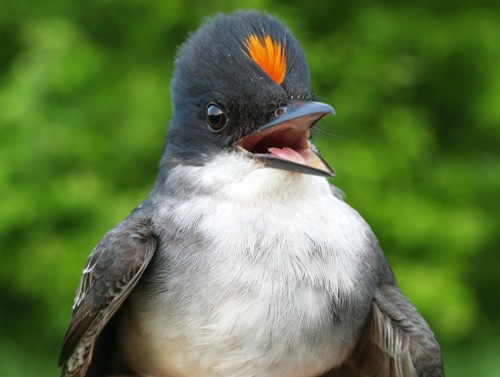 This Eastern Kingbird appears to be doing a good job of announcing the start of our seventh season of fall migration monitoring at MBO. (Photo by Simon Duval)
This Eastern Kingbird appears to be doing a good job of announcing the start of our seventh season of fall migration monitoring at MBO. (Photo by Simon Duval)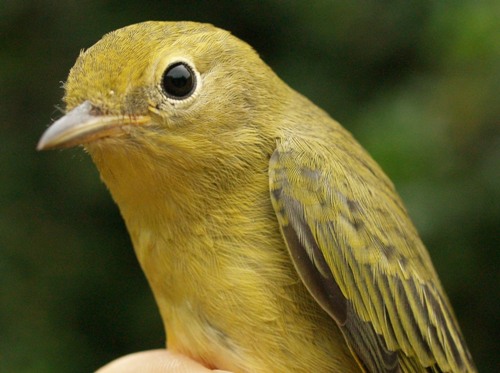 Yellow Warblers are the big surprise so far this fall, with more individuals banded over the past week than in any previous entire season! (Photo by Simon Duval)
Yellow Warblers are the big surprise so far this fall, with more individuals banded over the past week than in any previous entire season! (Photo by Simon Duval)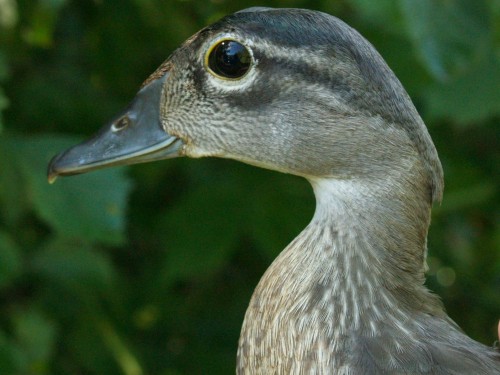 Although Wood Ducks are a common sight at MBO from late March to early November, we’ve never banded any until now. Four of them were hanging around the back ponds and were remarkably tame – to the extent that three of them were easy to catch and band. They were not part of the standard fall banding program and therefore will not appear in the season totals, but Wood Duck has become the 108th species banded at MBO. (Photo by Simon Duval)
Although Wood Ducks are a common sight at MBO from late March to early November, we’ve never banded any until now. Four of them were hanging around the back ponds and were remarkably tame – to the extent that three of them were easy to catch and band. They were not part of the standard fall banding program and therefore will not appear in the season totals, but Wood Duck has become the 108th species banded at MBO. (Photo by Simon Duval) The migration of Canada Warblers is always one of the highlights of August at MBO. Of all species listed on the Species at Risk Act as Threatened or Endangered, this is the one we encounter most frequently. Last fall we banded a record 35 Canada Warblers, and we are hoping to record a good number again this year. (Photo by Simon Duval)
The migration of Canada Warblers is always one of the highlights of August at MBO. Of all species listed on the Species at Risk Act as Threatened or Endangered, this is the one we encounter most frequently. Last fall we banded a record 35 Canada Warblers, and we are hoping to record a good number again this year. (Photo by Simon Duval)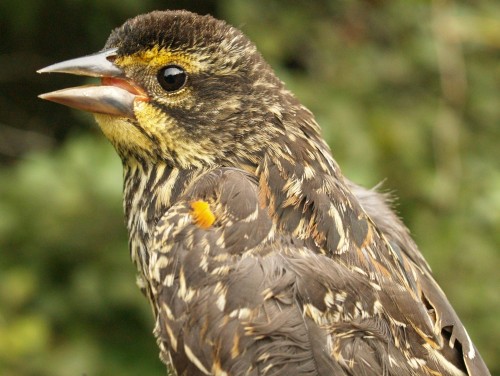 Red-winged Blackbirds are a rare catch at MBO over most of the fall season, with most of the birds banded in past years caught when stragglers from the late October flocks fly low enough through the woods adjacent to the back ponds and get caught in the B/N nets. This scruffy young male is only the third Red-winged Blackbird banded in August in 7 years. (Photo by Simon Duval)
Red-winged Blackbirds are a rare catch at MBO over most of the fall season, with most of the birds banded in past years caught when stragglers from the late October flocks fly low enough through the woods adjacent to the back ponds and get caught in the B/N nets. This scruffy young male is only the third Red-winged Blackbird banded in August in 7 years. (Photo by Simon Duval)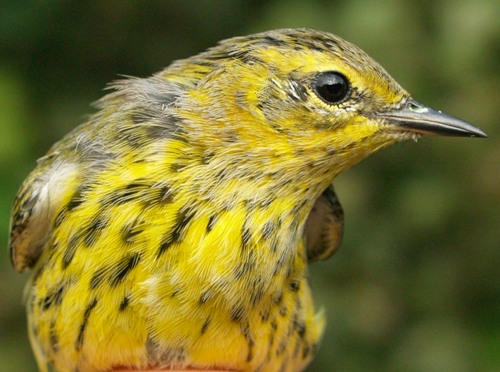 A nice bright Cape May Warbler, only the 19th one banded at MBO. (Photo by Simon Duval)
A nice bright Cape May Warbler, only the 19th one banded at MBO. (Photo by Simon Duval)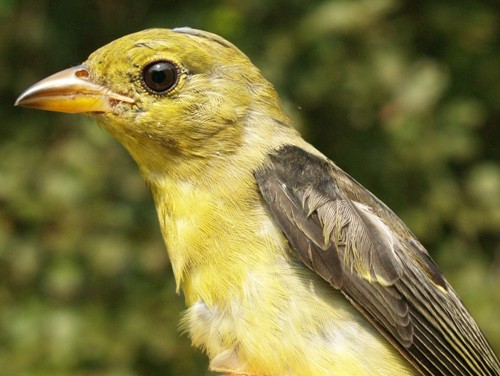 Over seven years, we have banded only 17 Scarlet Tanagers at MBO, all of them in fall, and in two of the last three years we’ve only banded one, so this individual was a particularly welcome highlight in an otherwise rather quiet week. (Photo by Simon Duval)
Over seven years, we have banded only 17 Scarlet Tanagers at MBO, all of them in fall, and in two of the last three years we’ve only banded one, so this individual was a particularly welcome highlight in an otherwise rather quiet week. (Photo by Simon Duval)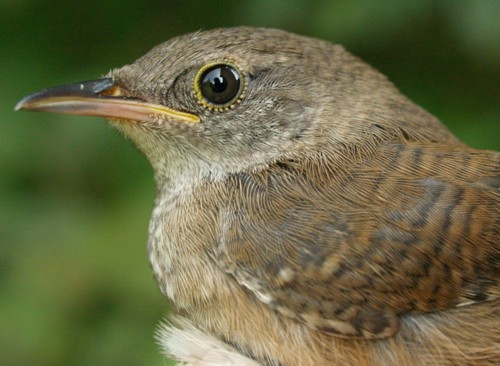 A young House Wren, still with a visibly broad juvenile gape. (Photo by Simon Duval)
A young House Wren, still with a visibly broad juvenile gape. (Photo by Simon Duval)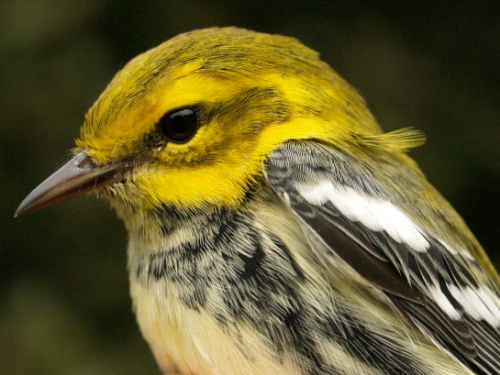 Black-throated Green Warbler migration at MBO usually peaks in September; the five banded this week (including the one above) was a record for any week in August. (Photo by Simon Duval)
Black-throated Green Warbler migration at MBO usually peaks in September; the five banded this week (including the one above) was a record for any week in August. (Photo by Simon Duval)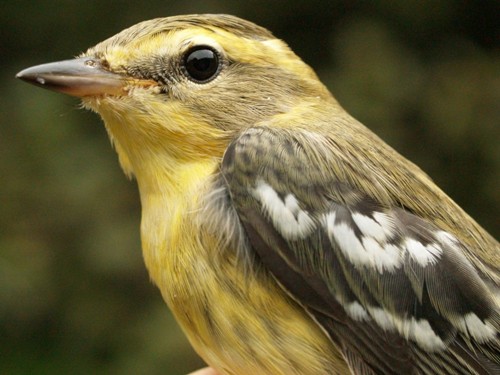 Roger Tory Peterson popularized the term “confusing fall warblers” and this pair of photos highlights a couple of the classic examples – a Blackburnian above, and a Blackpoll below. Although they are superficially quite similar, notice the more distinct yellowish supercilium on the Blackburnian, compared to the somewhat faint dark eyeline that is the most distinct feature on the Blackpoll’s face. Also the Blackburnian is a bit more yellowish, compared to the lightly greenish tone of the Blackpoll. (Photos by Simon Duval)
Roger Tory Peterson popularized the term “confusing fall warblers” and this pair of photos highlights a couple of the classic examples – a Blackburnian above, and a Blackpoll below. Although they are superficially quite similar, notice the more distinct yellowish supercilium on the Blackburnian, compared to the somewhat faint dark eyeline that is the most distinct feature on the Blackpoll’s face. Also the Blackburnian is a bit more yellowish, compared to the lightly greenish tone of the Blackpoll. (Photos by Simon Duval)
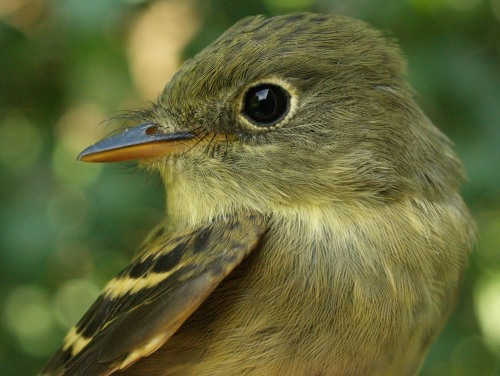 Although warblers were the story of the week, we did band a variety of other species too. Notable among them were the Yellow-bellied Flycatcher above (an August specialty at MBO), and the young Chipping Sparrow below (a species we rarely band until the second half of fall). (Photos by Simon Duval)
Although warblers were the story of the week, we did band a variety of other species too. Notable among them were the Yellow-bellied Flycatcher above (an August specialty at MBO), and the young Chipping Sparrow below (a species we rarely band until the second half of fall). (Photos by Simon Duval)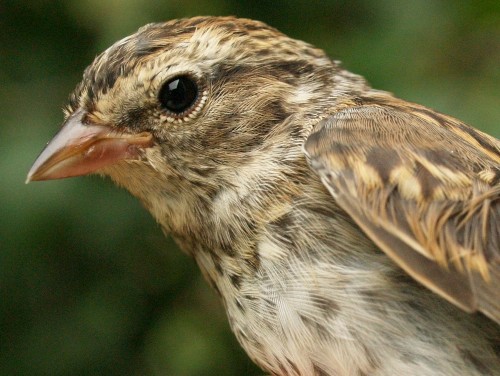
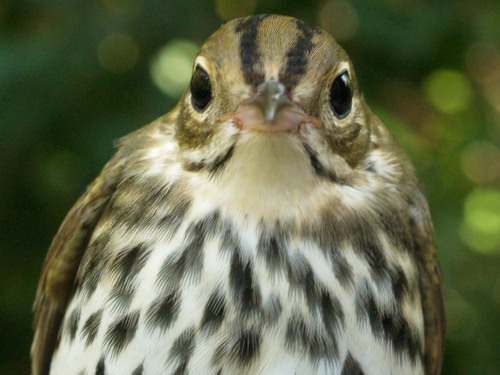 Ovenbirds are passing through MBO in good numbers this fall, with the 36 banded to date already representing an above-average total for the season, and no doubt at least a few more yet to come in September. (Photo by Simon Duval)
Ovenbirds are passing through MBO in good numbers this fall, with the 36 banded to date already representing an above-average total for the season, and no doubt at least a few more yet to come in September. (Photo by Simon Duval)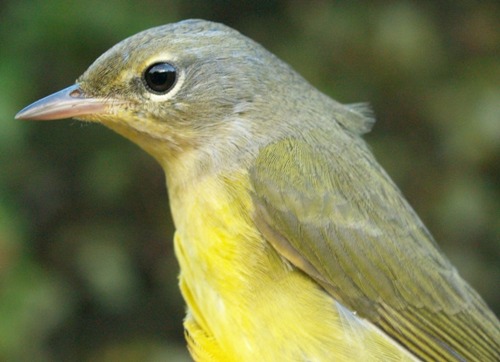 While warbler numbers have overall been great so far this fall, the increased abundance is not uniform. This Mourning Warbler was only the seventh banded at MBO this fall, and being an early migrant, the total may not rise much further, which could result in a record low count for fall. (Photo by Simon Duval)
While warbler numbers have overall been great so far this fall, the increased abundance is not uniform. This Mourning Warbler was only the seventh banded at MBO this fall, and being an early migrant, the total may not rise much further, which could result in a record low count for fall. (Photo by Simon Duval)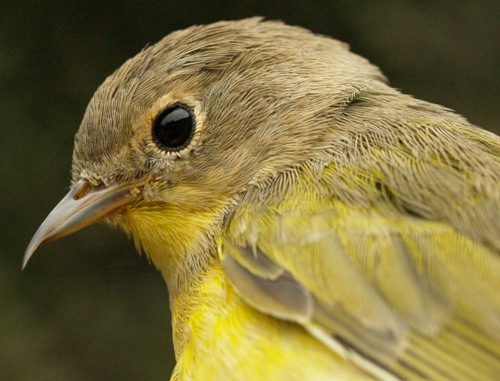 Continuing the “confusing fall warbler” comparison from last week, Nashville and Mourning Warblers can appear similar. The yellow throat and more complete gray hood of the Nashville Warbler set it apart; this particular individual is noteworthy for its overgrown upper mandible. (Photo by Simon Duval)
Continuing the “confusing fall warbler” comparison from last week, Nashville and Mourning Warblers can appear similar. The yellow throat and more complete gray hood of the Nashville Warbler set it apart; this particular individual is noteworthy for its overgrown upper mandible. (Photo by Simon Duval)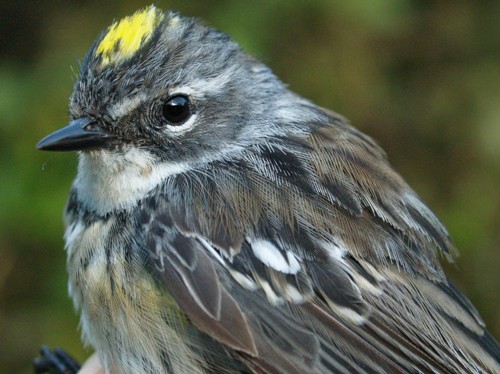 This scruffy-looking Yellow-rumped Warbler was the first of its kind banded at MBO this fall, but we expect the main migration is still at least another couple of weeks away. (Photo by Simon Duval)
This scruffy-looking Yellow-rumped Warbler was the first of its kind banded at MBO this fall, but we expect the main migration is still at least another couple of weeks away. (Photo by Simon Duval)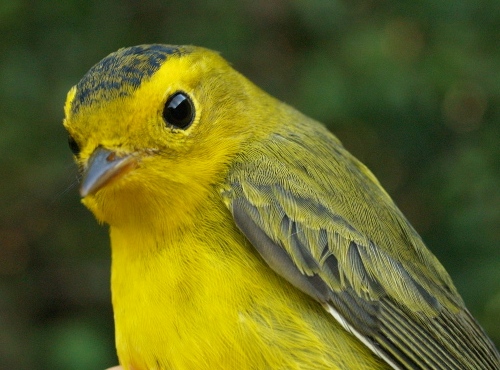 Also banded for the first time this fall were Wilson’s Warblers, with this being one of 15 that visited our nets this week. (Photo by Simon Duval)
Also banded for the first time this fall were Wilson’s Warblers, with this being one of 15 that visited our nets this week. (Photo by Simon Duval)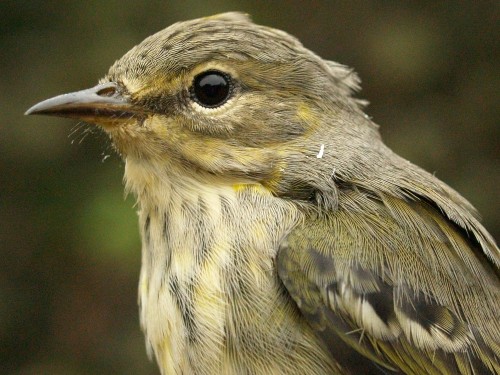 Our record count of Cape May Warblers this fall continues to grow – the one above was our 18th banded over the past six weeks, tripling our previous season high total. (Photo by Simon Duval)
Our record count of Cape May Warblers this fall continues to grow – the one above was our 18th banded over the past six weeks, tripling our previous season high total. (Photo by Simon Duval)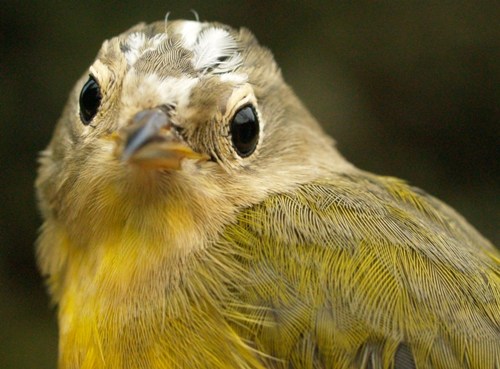 Every once in a while we catch an individual with some white feathers in unusual places, including this Nashville Warbler with an unusually decorated crown. (Photo by Simon Duval)
Every once in a while we catch an individual with some white feathers in unusual places, including this Nashville Warbler with an unusually decorated crown. (Photo by Simon Duval)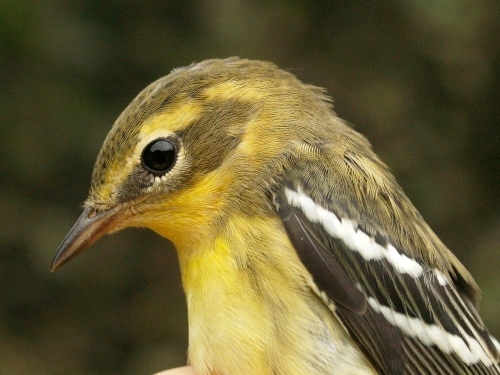 Although still comparatively scarce, with only 6 individuals banded this fall, Blackburnian Warbler is another of the several warbler species with above-average numbers this fall. (Photo by Simon Duval)
Although still comparatively scarce, with only 6 individuals banded this fall, Blackburnian Warbler is another of the several warbler species with above-average numbers this fall. (Photo by Simon Duval)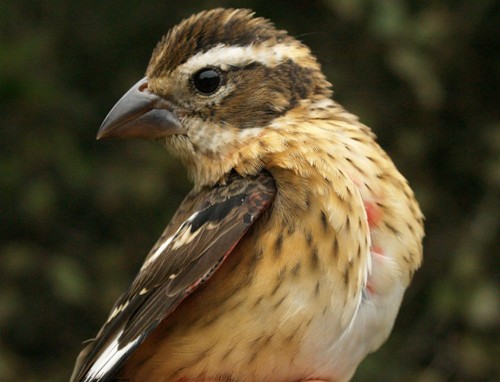 Unlike the warblers, Rose-breasted Grosbeak is among the species that has been unusually rare this fall. This was only our 14th individual of the season, compared to an average of over 30 by the end of week 6 in previous years. Given that numbers usually peak in early August, we will almost certainly have a record low total this fall. (Photo by Simon Duval)
Unlike the warblers, Rose-breasted Grosbeak is among the species that has been unusually rare this fall. This was only our 14th individual of the season, compared to an average of over 30 by the end of week 6 in previous years. Given that numbers usually peak in early August, we will almost certainly have a record low total this fall. (Photo by Simon Duval)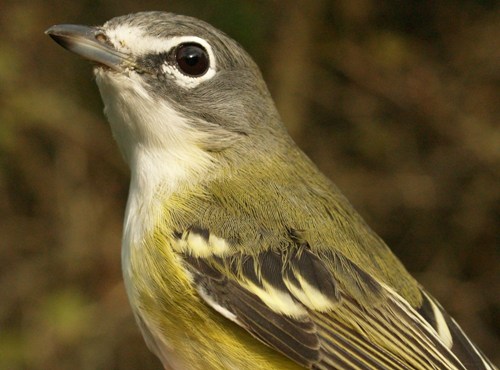 Our first Blue-headed Vireo banded this fall, right on schedule. (Photo by Simon Duval)
Our first Blue-headed Vireo banded this fall, right on schedule. (Photo by Simon Duval) A nice frontal view of a Lincoln’s Sparrow. (Photo by Simon Duval)
A nice frontal view of a Lincoln’s Sparrow. (Photo by Simon Duval)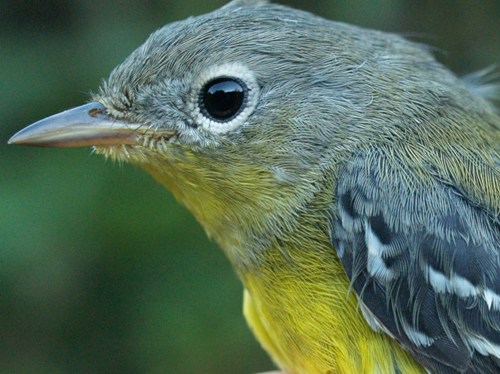 One of the many Magnolia Warblers banded this fall, still leading the season tally by a wide margin over two other warbler species. (Photo by Simon Duval)
One of the many Magnolia Warblers banded this fall, still leading the season tally by a wide margin over two other warbler species. (Photo by Simon Duval)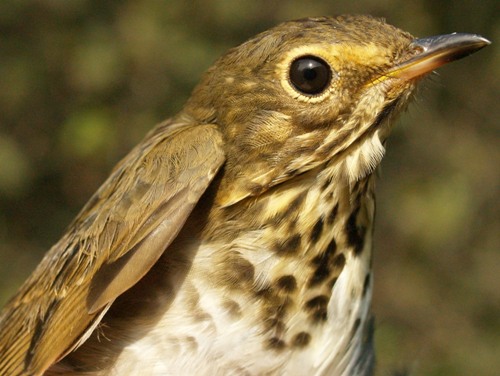 Week 7 has historically been the peak of Swainson’s Thrush migration, but this year the species has been trickling through, with two in week 1, one in week 3, two in week 5, three last week, and the one above this week. (Photo by Simon Duval)
Week 7 has historically been the peak of Swainson’s Thrush migration, but this year the species has been trickling through, with two in week 1, one in week 3, two in week 5, three last week, and the one above this week. (Photo by Simon Duval) This boldly marked after-hatch-year male was one of three Northern Parulas banded at MBO this week, becoming the 22nd warbler species banded this fall. (Photo by Simon Duval)
This boldly marked after-hatch-year male was one of three Northern Parulas banded at MBO this week, becoming the 22nd warbler species banded this fall. (Photo by Simon Duval) Although overall numbers were low this week, diversity was above average with 41 species banded, compared to a six-year average of 38. Among them were two relatively uncommon species, both of which have been banded fewer than 50 times, the Grey-cheeked Thrush above, and Philadelphia Vireo below. (Photos by Gay Gruner)
Although overall numbers were low this week, diversity was above average with 41 species banded, compared to a six-year average of 38. Among them were two relatively uncommon species, both of which have been banded fewer than 50 times, the Grey-cheeked Thrush above, and Philadelphia Vireo below. (Photos by Gay Gruner)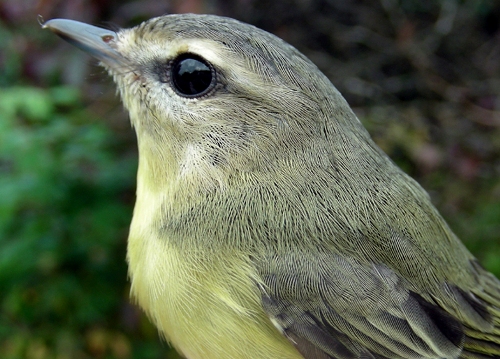
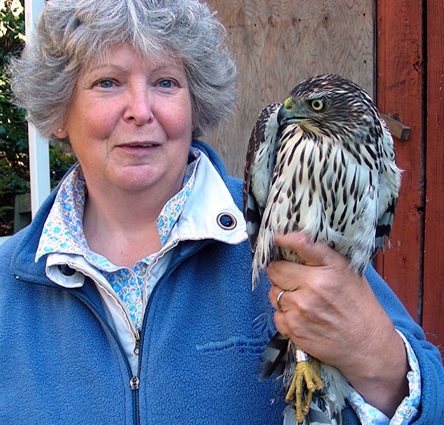 Gay Gruner, one of our dedicated Banders-in-Charge, holding just the second Cooper’s Hawk ever banded at MBO. (Photo by Barbara MacDuff)
Gay Gruner, one of our dedicated Banders-in-Charge, holding just the second Cooper’s Hawk ever banded at MBO. (Photo by Barbara MacDuff)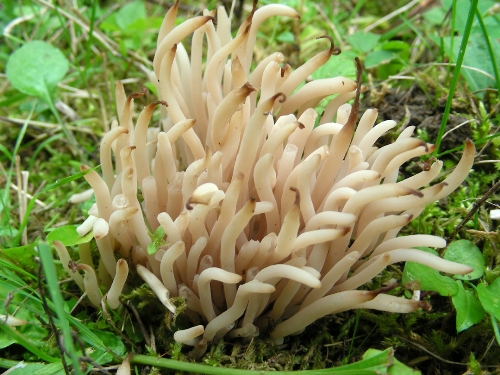 Although we focus on the birds at MBO, we always keep an eye on our other natural surroundings too, such as this saprophyte near our D3 net. (Photo by Gay Gruner)
Although we focus on the birds at MBO, we always keep an eye on our other natural surroundings too, such as this saprophyte near our D3 net. (Photo by Gay Gruner)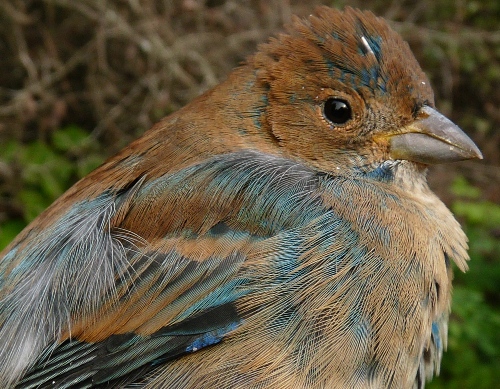 This male Indigo Bunting was one of the week’s highlights, largely because it was the first time we recaptured it since banding it as a hatch-year bird (sex unknown at the time) on 21 September 2009. (Photo by Marcel Gahbauer)
This male Indigo Bunting was one of the week’s highlights, largely because it was the first time we recaptured it since banding it as a hatch-year bird (sex unknown at the time) on 21 September 2009. (Photo by Marcel Gahbauer)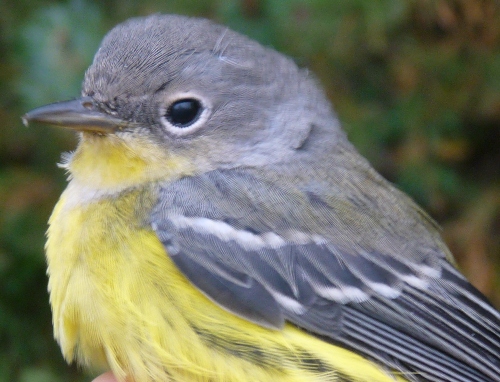 Last year at this time we noticed that several adult Yellow-rumped Warblers had not quite completed molt of their secondaries. We have seen a few similar cases again this year, but this female Magnolia Warbler marks the first time we have documented such a delayed molt for this species (see below the contrast in the length of secondaries 4 through 6, compared with the adjacent fully grown tertials) (Photos by Marcel Gahbauer)
Last year at this time we noticed that several adult Yellow-rumped Warblers had not quite completed molt of their secondaries. We have seen a few similar cases again this year, but this female Magnolia Warbler marks the first time we have documented such a delayed molt for this species (see below the contrast in the length of secondaries 4 through 6, compared with the adjacent fully grown tertials) (Photos by Marcel Gahbauer)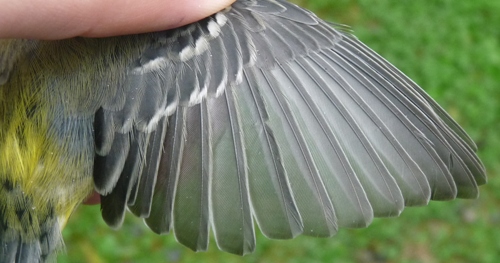
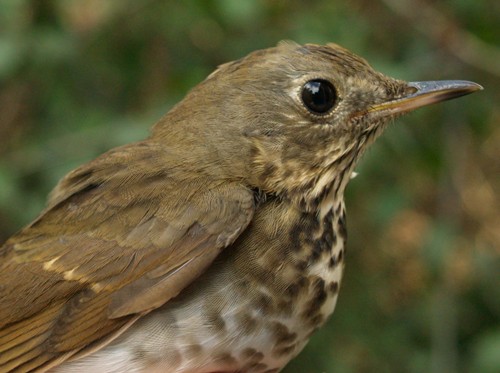 A rare species at MBO, this was only the third Bicknell’s Thrush banded in 7 years. (Photo by Simon Duval)
A rare species at MBO, this was only the third Bicknell’s Thrush banded in 7 years. (Photo by Simon Duval)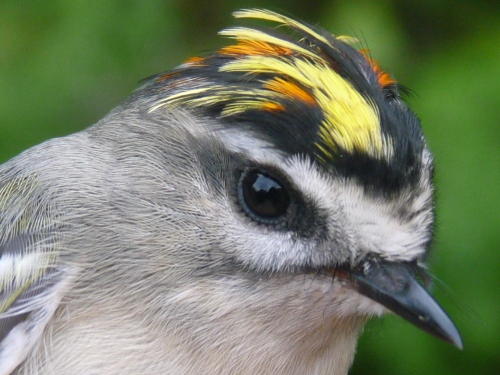 Week 9 is traditionally the start of the main part of “kinglet season”, and unlike many other species, Golden-crowned Kinglets were unusually common this week. As such, we can’t resist including a photo of one of the males we banded. (Photo by Marcel Gahbauer)
Week 9 is traditionally the start of the main part of “kinglet season”, and unlike many other species, Golden-crowned Kinglets were unusually common this week. As such, we can’t resist including a photo of one of the males we banded. (Photo by Marcel Gahbauer)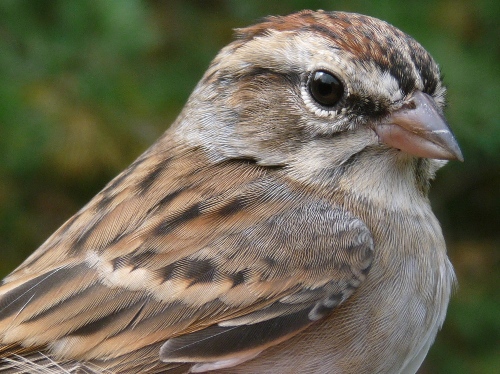 In terms of numbers, one of our few other pleasant surprises this week came in the form of a minor Chipping Sparrow invasion. One morning we watched a stream of at least 15 moving along the east side of Stoneycroft Pond, although we only ended up catching and banding one of them. A couple of days later we had 8 together in net E2 on our closing round, eclipsing the total banded all of last fall (6) and boosting the 2011 fall count to a record high 28. (Photo by Marcel Gahbauer)
In terms of numbers, one of our few other pleasant surprises this week came in the form of a minor Chipping Sparrow invasion. One morning we watched a stream of at least 15 moving along the east side of Stoneycroft Pond, although we only ended up catching and banding one of them. A couple of days later we had 8 together in net E2 on our closing round, eclipsing the total banded all of last fall (6) and boosting the 2011 fall count to a record high 28. (Photo by Marcel Gahbauer)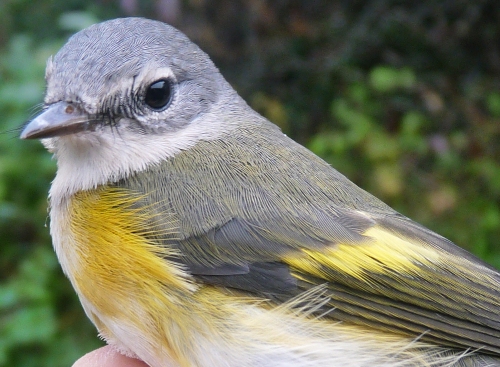 This hatch-year American Redstart banded on the first day of the week was only the second we have ever banded in late October, and extended the total for fall 2011 to 150, which is a new record high for the fifth year in a row! (Photo by Marcel Gahbauer)
This hatch-year American Redstart banded on the first day of the week was only the second we have ever banded in late October, and extended the total for fall 2011 to 150, which is a new record high for the fifth year in a row! (Photo by Marcel Gahbauer)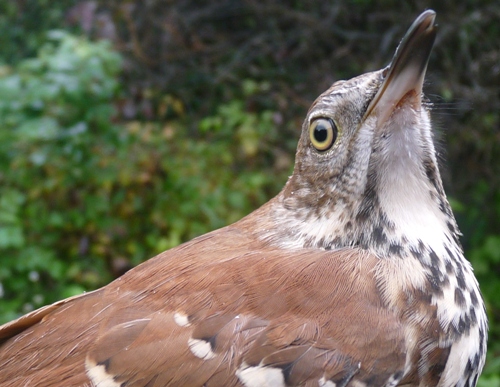 Another surprisingly late bird, this Brown Thrasher was only the third we have ever banded in October – and surprisingly the first one we’ve banded this fall. Below is a “crossbill” of sorts that we banded on Monday, but alas not the kind that we have long been hoping to band at MBO. Rather, this is a Blue-headed Vireo with an unfortunate deformity of its upper mandible. (Photos by Marcel Gahbauer)
Another surprisingly late bird, this Brown Thrasher was only the third we have ever banded in October – and surprisingly the first one we’ve banded this fall. Below is a “crossbill” of sorts that we banded on Monday, but alas not the kind that we have long been hoping to band at MBO. Rather, this is a Blue-headed Vireo with an unfortunate deformity of its upper mandible. (Photos by Marcel Gahbauer)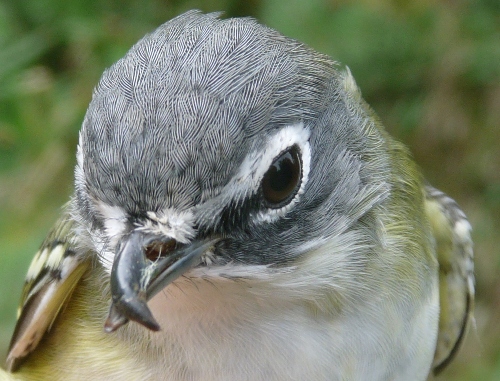
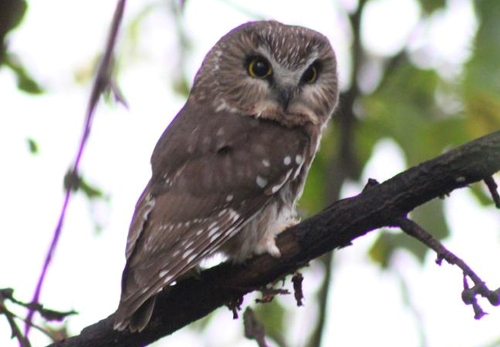 In our seventh year of fall migration monitoring, and our fifth year of Northern Saw-whet Owl research, the owl pictured above was our first daylight sighting ever! (Photo by Matthew Von Bornhoft)
In our seventh year of fall migration monitoring, and our fifth year of Northern Saw-whet Owl research, the owl pictured above was our first daylight sighting ever! (Photo by Matthew Von Bornhoft)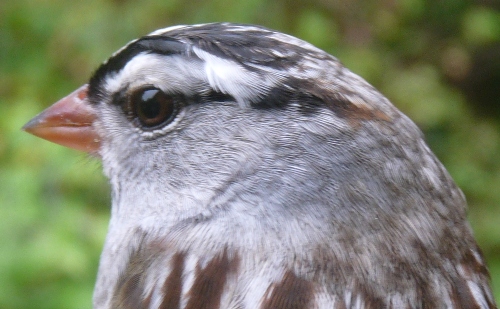 In spring, we wondered whether perhaps White-crowned Sparrows that show a bit of brown at the rear end of their black crown stripes might be second-year birds that had not completely molted the feathers from their juvenile plumage. However, as the after-hatch-year individual above demonstrates, even older birds can show that pattern. Conversely, the hatch-year bird below is already showing flecks of black and white on its crown, and has an unusual pale spot at the front of its central crown stripe. (Photos by Marcel Gahbauer)
In spring, we wondered whether perhaps White-crowned Sparrows that show a bit of brown at the rear end of their black crown stripes might be second-year birds that had not completely molted the feathers from their juvenile plumage. However, as the after-hatch-year individual above demonstrates, even older birds can show that pattern. Conversely, the hatch-year bird below is already showing flecks of black and white on its crown, and has an unusual pale spot at the front of its central crown stripe. (Photos by Marcel Gahbauer)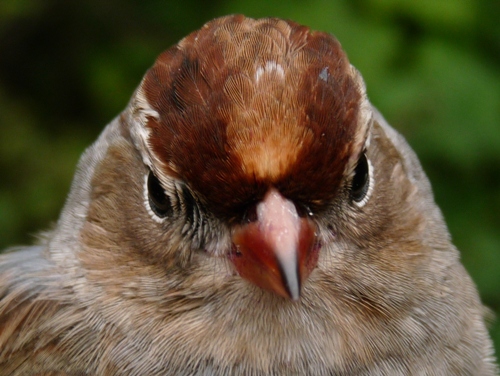
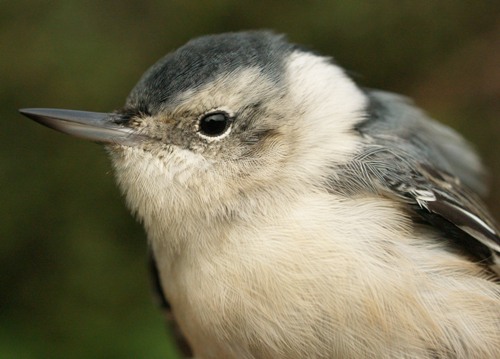 This week’s highlight was this female White-breasted Nuthatch, a resident species at MBO, but just the 6th individual banded in 7 years, and the first since 2009. (Photo by Simon Duval)
This week’s highlight was this female White-breasted Nuthatch, a resident species at MBO, but just the 6th individual banded in 7 years, and the first since 2009. (Photo by Simon Duval)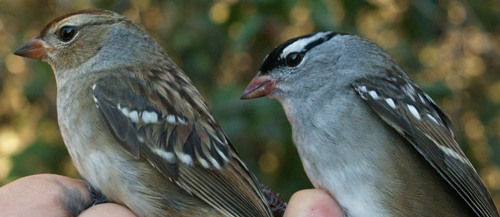 White-crowned Sparrow is one of the species that has been unusually scarce this fall, with only 14 banded to date, compared to previous season totals of 20 to 80. However, we did at least catch a hatch-year and after-hatch-year bird together at one point for this nice side-by-side comparison. (Photo by Simon Duval)
White-crowned Sparrow is one of the species that has been unusually scarce this fall, with only 14 banded to date, compared to previous season totals of 20 to 80. However, we did at least catch a hatch-year and after-hatch-year bird together at one point for this nice side-by-side comparison. (Photo by Simon Duval)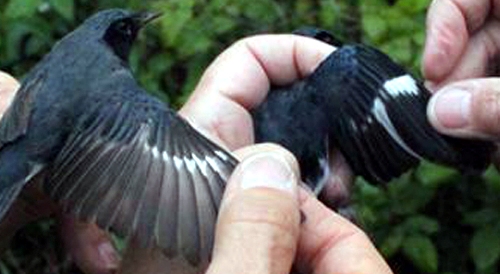 Another nice comparison was provided by these two male Black-throated Blue Warblers, a hatch-year bird on the left, and a much more boldly marked after-hatch-year bird on the right. (Photo by Matthew Von Bornhoft)
Another nice comparison was provided by these two male Black-throated Blue Warblers, a hatch-year bird on the left, and a much more boldly marked after-hatch-year bird on the right. (Photo by Matthew Von Bornhoft)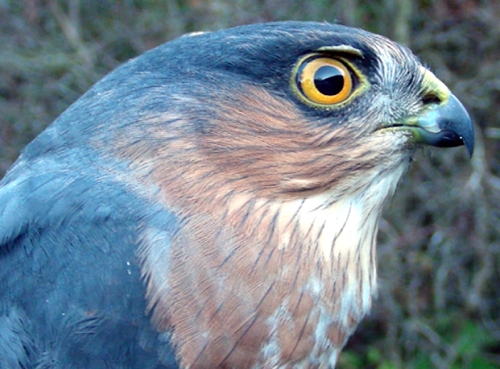 This week we banded our fifth Sharp-shinned Hawk of the fall, and for once it was an after-hatch-year bird (the vast majority of our raptor captures are hatch-year individuals) (Photos by Gay Gruner)
This week we banded our fifth Sharp-shinned Hawk of the fall, and for once it was an after-hatch-year bird (the vast majority of our raptor captures are hatch-year individuals) (Photos by Gay Gruner)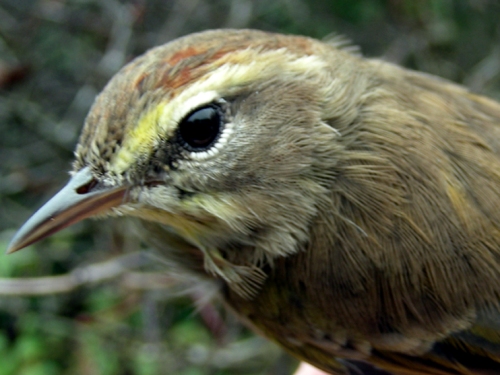 It was our poorest fall count ever for Palm Warblers, with only 7 individuals banded, but we did at least have a chance to compare Yellow Palm Warbler (above) and Western Palm Warbler (below). (Photos by Gay Gruner)
It was our poorest fall count ever for Palm Warblers, with only 7 individuals banded, but we did at least have a chance to compare Yellow Palm Warbler (above) and Western Palm Warbler (below). (Photos by Gay Gruner)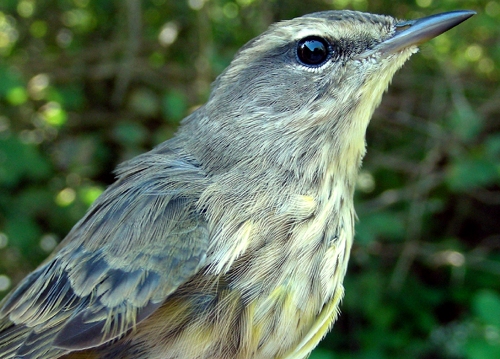
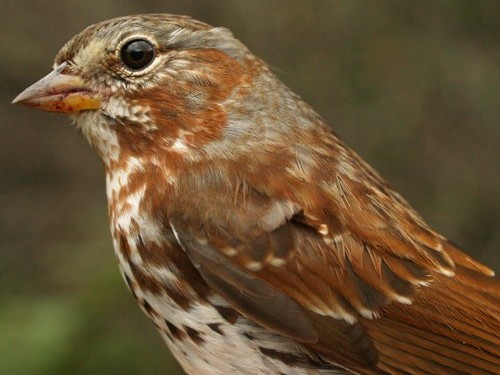 Fox Sparrows increased at MBO this week, although this was one of only three individuals banded, just half of what we would expect on average during week 12. (Photo by Simon Duval)
Fox Sparrows increased at MBO this week, although this was one of only three individuals banded, just half of what we would expect on average during week 12. (Photo by Simon Duval)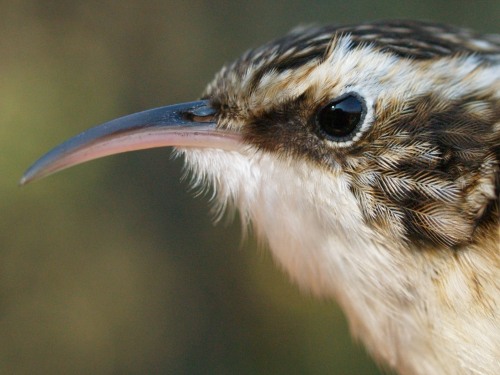 Even though it has been a slow fall overall, we have still had record numbers of some species, including Brown Creeper – this was our 14th individual banded, with the previous record for a fall season being 12 back in our first full fall program in 2005. (Photo by Simon Duval)
Even though it has been a slow fall overall, we have still had record numbers of some species, including Brown Creeper – this was our 14th individual banded, with the previous record for a fall season being 12 back in our first full fall program in 2005. (Photo by Simon Duval)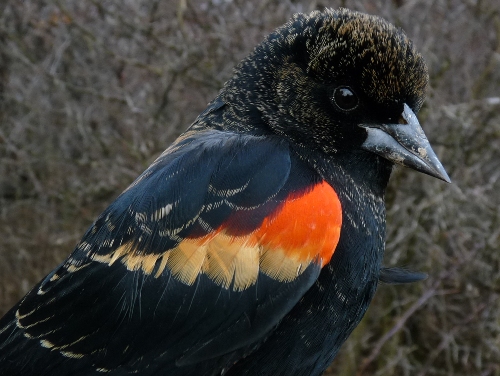 Red-winged Blackbirds are not commonly banded at MBO in fall, in sharp contrast to spring when they are typically among the three most numerous species. The 8 individuals banded this week is the third highest single-week banding total for fall. (Photo by Marcel Gahbauer)
Red-winged Blackbirds are not commonly banded at MBO in fall, in sharp contrast to spring when they are typically among the three most numerous species. The 8 individuals banded this week is the third highest single-week banding total for fall. (Photo by Marcel Gahbauer)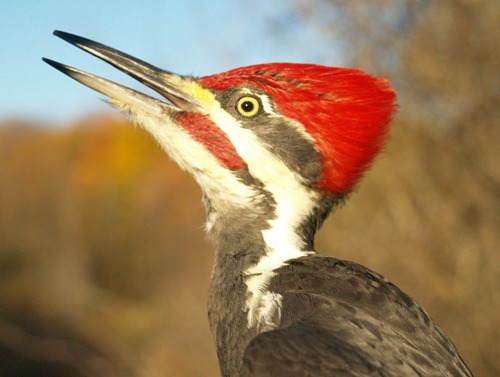 Always an impressive bird, this Pileated Woodpecker was just the fifth of its kind ever banded at MBO, and the 77th and final addition to the list of species banded this fall. (Photo by Simon Duval)
Always an impressive bird, this Pileated Woodpecker was just the fifth of its kind ever banded at MBO, and the 77th and final addition to the list of species banded this fall. (Photo by Simon Duval)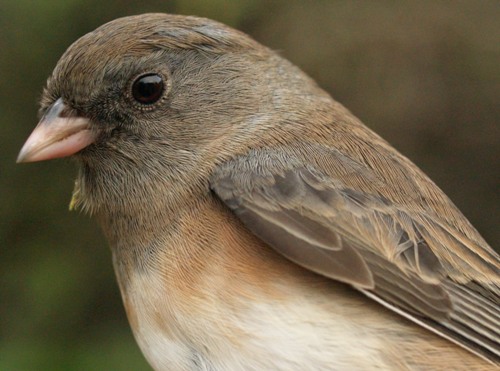 We generally consider the juncos at MBO to be Slate-colored Juncos – the race of Dark-eyed Junco that is a common breeder across most of the boreal forest. However, every once in a while we get one like this that looks like a good candidate for Pink-sided Junco, which breeds in the Central Rockies. (Photos by Simon Duval)
We generally consider the juncos at MBO to be Slate-colored Juncos – the race of Dark-eyed Junco that is a common breeder across most of the boreal forest. However, every once in a while we get one like this that looks like a good candidate for Pink-sided Junco, which breeds in the Central Rockies. (Photos by Simon Duval)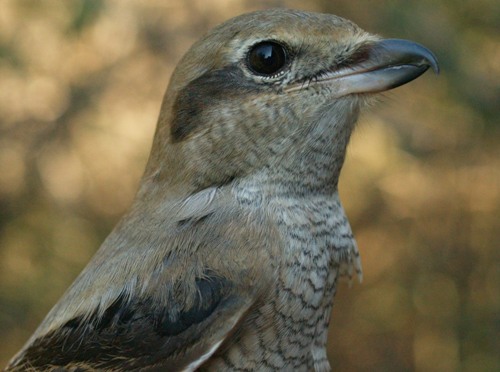 For the fourth time in 7 years, we banded a Northern Shrike in the last week of fall. (Photo by Simon Duval)
For the fourth time in 7 years, we banded a Northern Shrike in the last week of fall. (Photo by Simon Duval)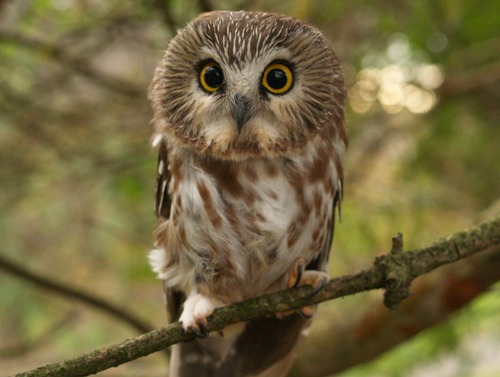 Our second “diurnal” Northern Saw-whet Owl of the fall, posing nicely for a photo after being banded by the passerine crew. A reminder that individual owls are now available through MBO’s
Our second “diurnal” Northern Saw-whet Owl of the fall, posing nicely for a photo after being banded by the passerine crew. A reminder that individual owls are now available through MBO’s